Gaze across the Strait of Gibraltar to Africa, explore an underground fantasyland of limestone chambers, see macaques in a nature preserve, visit an ancient Moorish castle, and tour a labyrinth of war tunnels…these are all things to do on the Rock of Gibraltar.
The Rock of Gibraltar is an immense limestone promontory that sits near the entrance of the Mediterranean Sea. This mountain has long been steeped in legend and was thought to be one of the pillars of Hercules.
For us the Rock of Gibraltar was full of surprises and blew away our expectations. With its hiking and walking trails, nature preserve, and extraordinary views from its highest points, Tim and I loved this experience. Add in the macaques, St. Michael’s Cave, a skywalk, and siege and war tunnels, and there is something here for everyone.
In this guide, we lay out exactly how to visit the Rock Gibraltar plus several itineraries to help you plan your time.
Where is the Rock of Gibraltar?
The Rock of Gibraltar is a limestone promontory that is located in a British overseas territory called Gibraltar. Gibraltar is located in the Mediterranean Sea on the Iberian Peninsula. It is a tiny territory, just 6.7 square kilometers (2.6 square miles) and most of its landmass is the Rock of Gibraltar.
Gibraltar sits next to the Strait of Gibraltar, where the Mediterranean Sea and Atlantic Ocean meet.
Gibraltar is fortified British air and naval base with a prime strategic location on the Strait of Gibraltar.
This has been a British territory since 1704, when it was captured by the British during the War of the Spanish Succession. More than 300 years later, Gibraltar remains a point of contention between Great Britain and Spain.
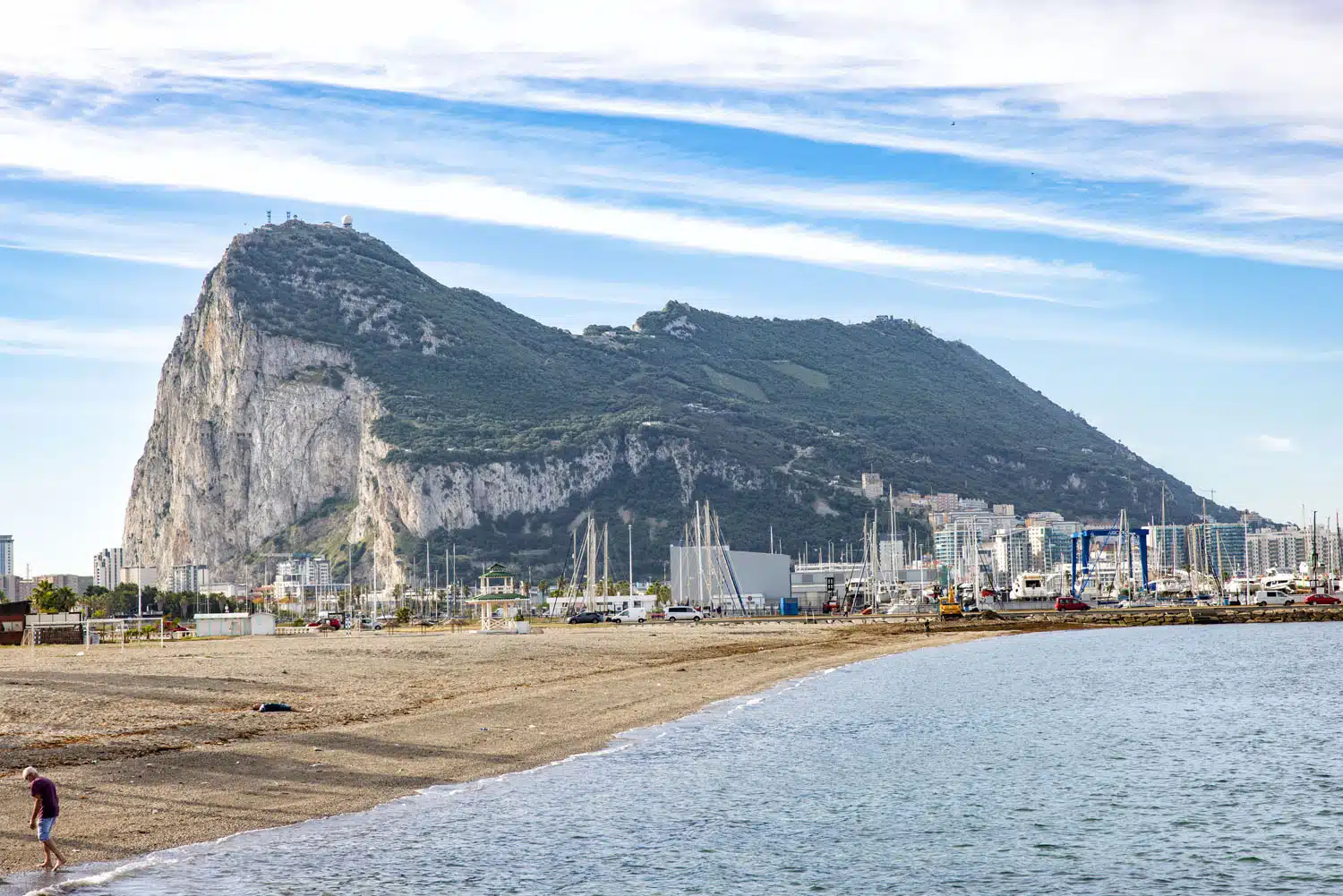
Interesting Facts about the Rock of Gibraltar
The Rock of Gibraltar is a mountain made of limestone rock that sits beside the western entrance into the Mediterranean Sea. At its highest point, it sits 426 meters (1,398 feet) high.
Because of its strategic position on Strait of Gibraltar, this promontory serves as a fortress. A network of tunnels runs through the Rock of Gibraltar, and these were used both during the War of the Spanish Succession and World War II. Touring these labyrinths of tunnels is just one of many things to do on the Rock of Gibraltar.
The Rock of Gibraltar is one of the two Pillars of Hercules. This was the northernmost pillar, called Mons Calpe (Mount Calpe) by the Romans. The second pillar sits on the African side of the strait, although its exact location is contested. The southern pillar is either Mount Hacho (near Ceuta) or Jebel Moussa (in Morocco).
The upper portion of the Rock of Gibraltar is a nature preserve. Its most famous residents are Barbary macaques, which have lived here for hundreds of years. According to legend, British dominion of Gibraltar will end when the macaques are no longer present. Also in the nature preserve are rabbits, foxes, and the beautiful Gibraltar candytuft (a flowering plant).

A macaque dining on Gibraltar Candytuft
Best Things to Do on the Rock of Gibraltar
Next is a list of things to do on the Rock of Gibraltar. These are listed somewhat geographically, starting at the top of the Rock and ending lower down near town.
Just as a very quick overview, there are three ways to reach the top of the Rock of Gibraltar: cable car, Mediterranean Steps (basically a challenging uphill hike), or a taxi.
We get into the order of how to see all these in the itineraries later in this guide, but we’ve listed things in the order below because most likely that’s how you will visit them.
Note: This list is only for things to do on the Rock of Gibraltar. It does not include other things to do in Gibraltar (although this list is rather short).
How to Use This Map: Click the icons on the map to get more information about each point of interest. To take this map with you, click the star next to the title of the map which adds it to your Google account. Next, within your Google Maps app, select ‘Saved’ and then select ‘Maps’. This map title will now appear in your list.
1. Mediterranean Steps
The Mediterranean Steps is a hiking path that runs from Queen’s Road (on the south side of the nature reserve) almost to the highest point of the Rock of Gibraltar.
Many people walk the steps down, at the end of their visit, but if you want to get some extra exercise, or bragging rights that you climbed to the top of the Rock of Gibraltar, this is the perfect way to start your visit. It’s what we did and loved it.
Mediterranean Steps Hiking Stats
Distance: 1.9 kilometers/1.2 miles one-way
Total Ascent: 400 meters/1330 feet
Total Descent: 175 meters/580 feet
Difficulty: Challenging
Time: 30 to 60 minutes
The stats above are for walking up the Mediterranean Steps. If you choose to walk down the trail, it will be 400 meters of descent and 175 meters of ascent.
The starting point of this hike is in the nature preserve, next to the Old Jews’ Cemetery. At this spot, there are bathrooms, a plaque marking the Pillars of Hercules, and a viewpoint of Europa Point.
To do this hike, you will need a ticket to visit the nature preserve, which you can purchase at the ticket booth next to the trailhead. This ticket will give you access to everything else on this list, including the Skywalk, St. Michael’s Cave, the WWII tunnels, and more, with the exception of the cable car. The ticket booth opens around 9:30 am (check hours on Google Maps before you go).
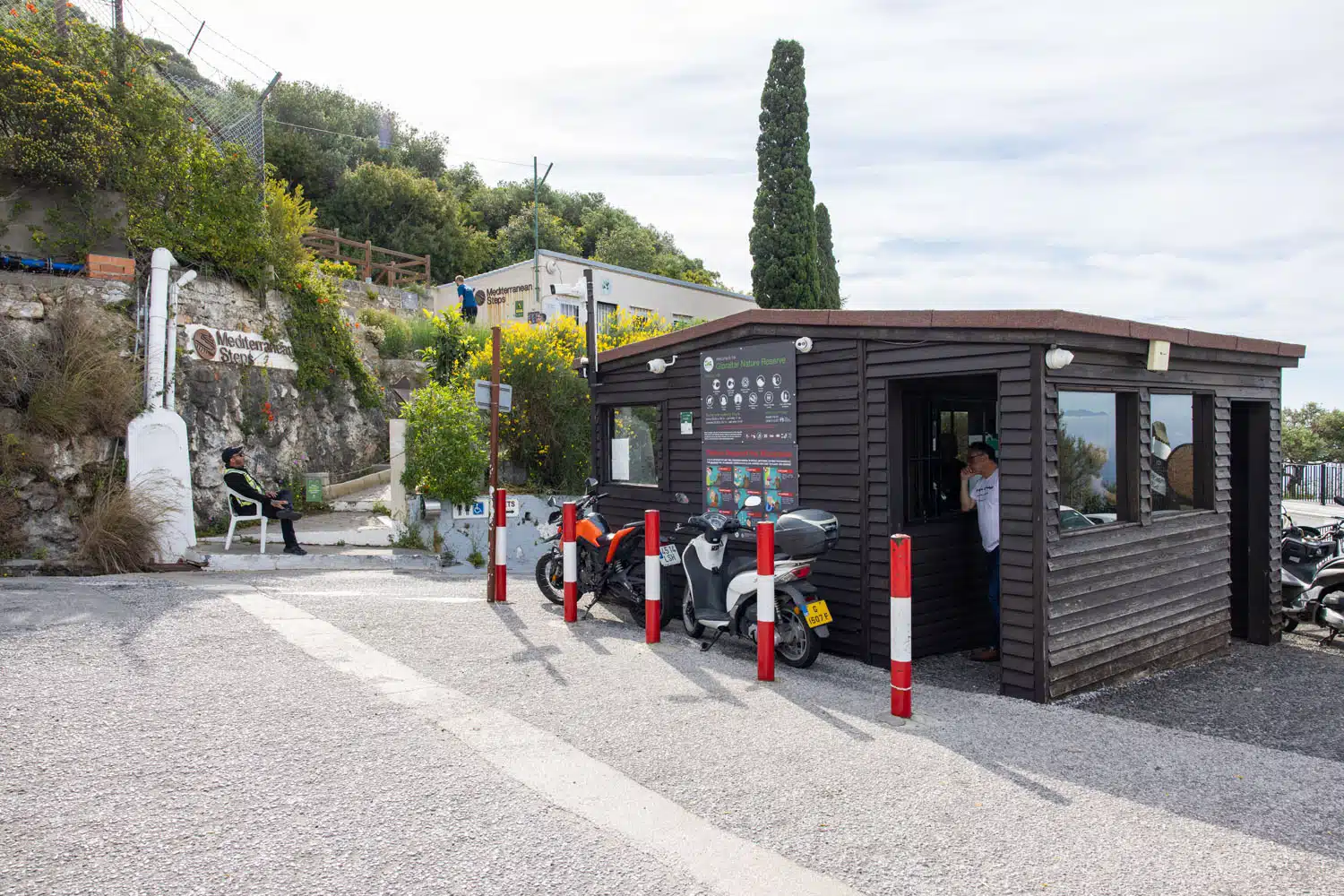
The ticket booth and the bottom of the Mediterranean Steps
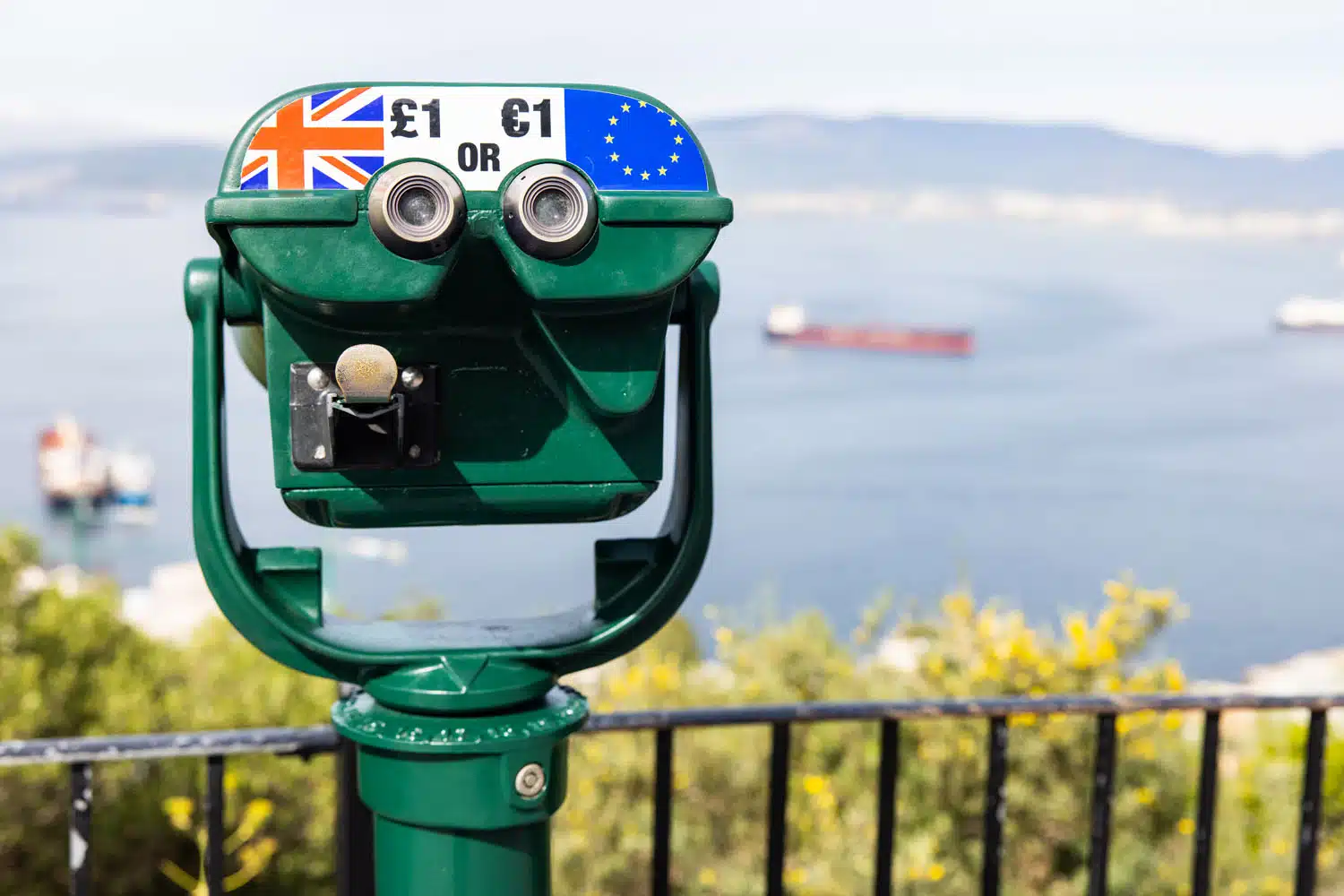
Behind the ticket booth is a viewpoint of the Strait of Gibraltar. The views get much better once you start hiking the Mediterranean Steps trail.
The Mediterranean Steps Hike
Here is an overview of the hike.
The first third of the hike is the easiest. It starts off with a few steps and then transforms into a hiking trail. It is rather flat early on and offers a really nice view of Europa Point.
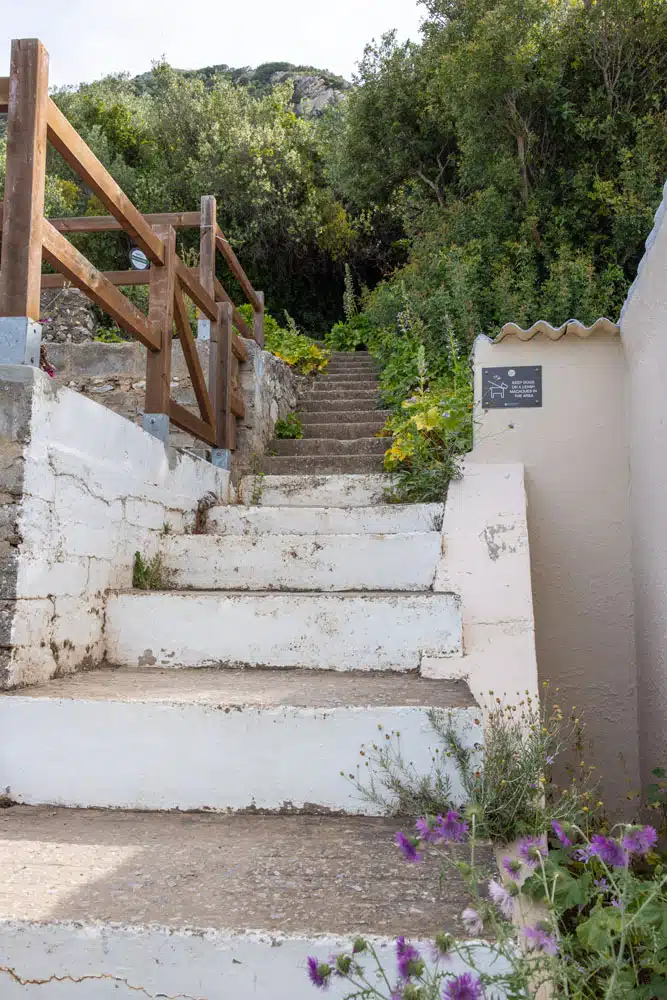
The trail starts of with a few stairs and then quickly levels out.
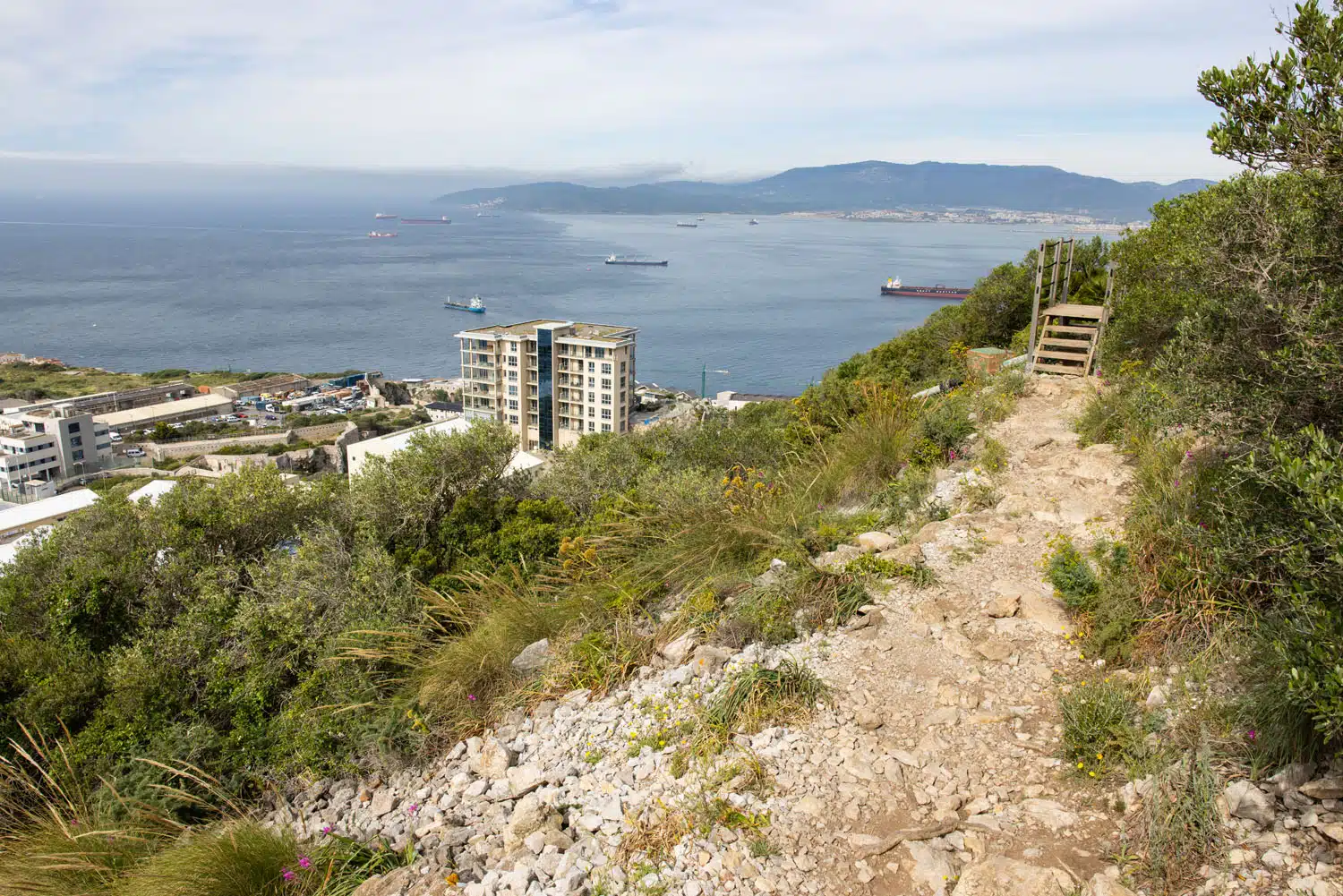
Here is the first part of the trail. And below is the view of Europe Point from this same spot.
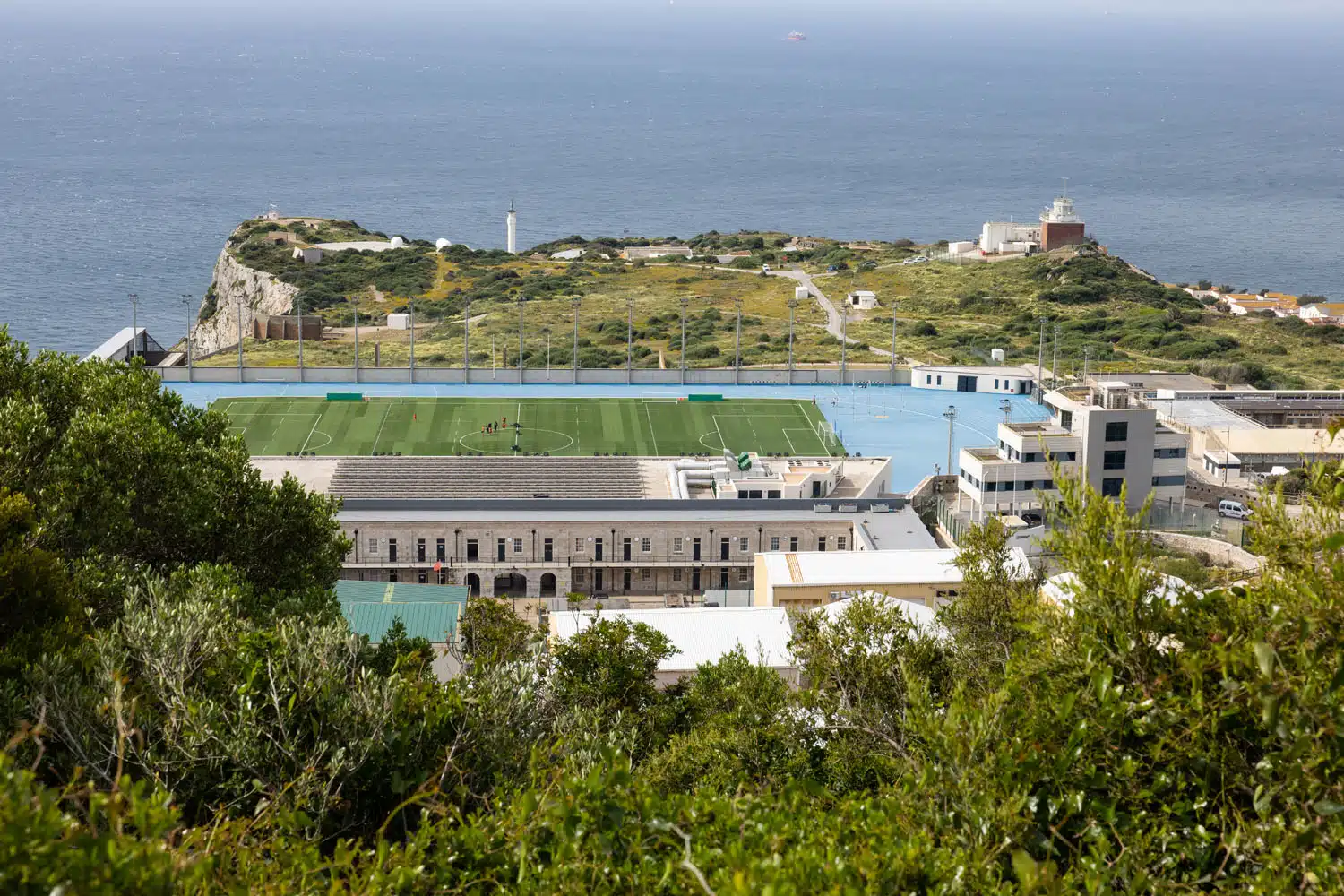
Europa Point
Then the trail makes a fairly big descent, and you’ll walk down several long staircases. It can be a bit unnerving because you have to climb up the huge wall to the left of you and any descent now just means more climbing later.
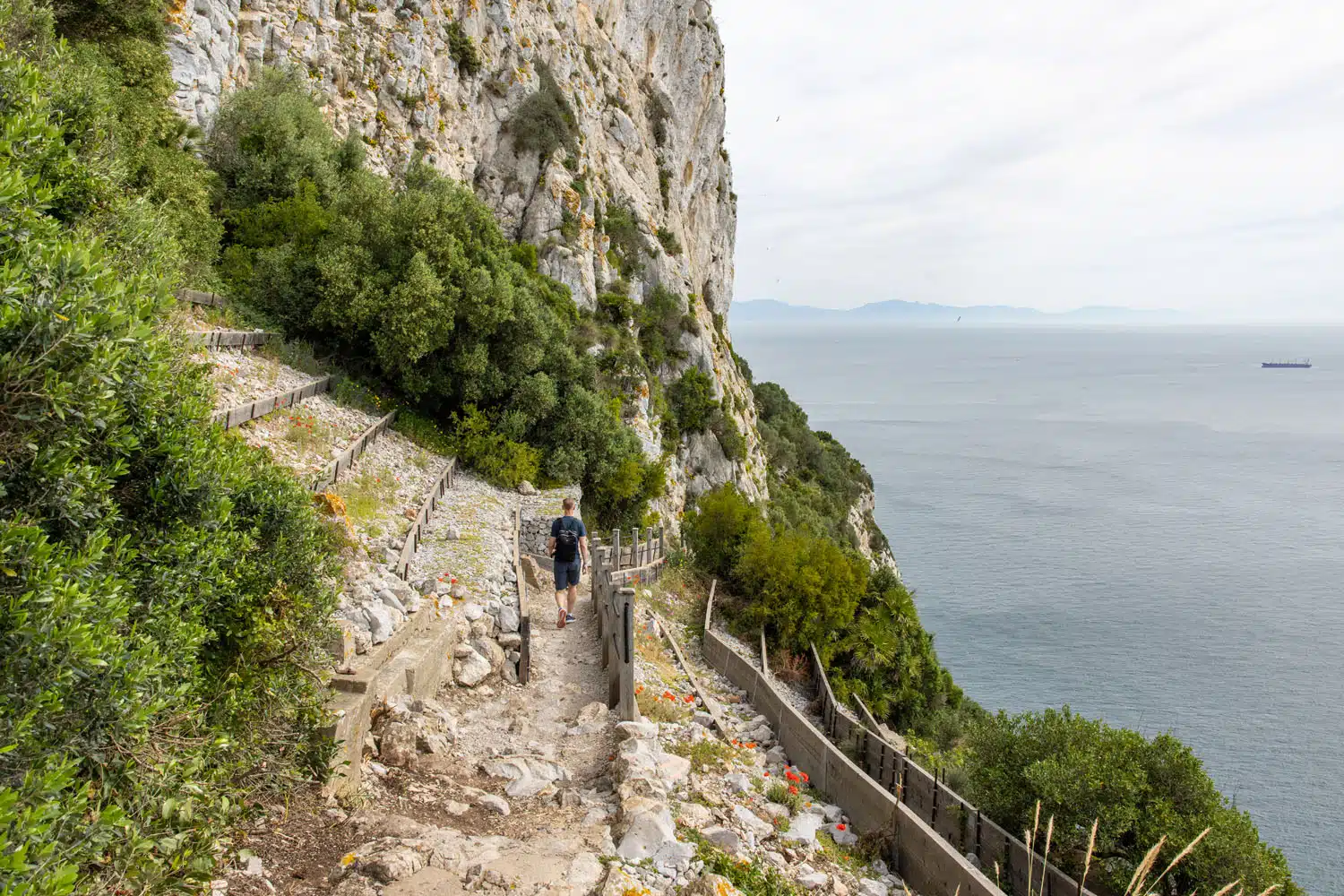
Roughly 500 meters/0.33 miles into the hike you reach your first stair climb. Tim counted approximately 210 steps here. These are big steps and there is a railing in some spots should you need to pull yourself up using your arms. At the top of the steps, you are back on the hiking trail, and it is a slow incline at this point.
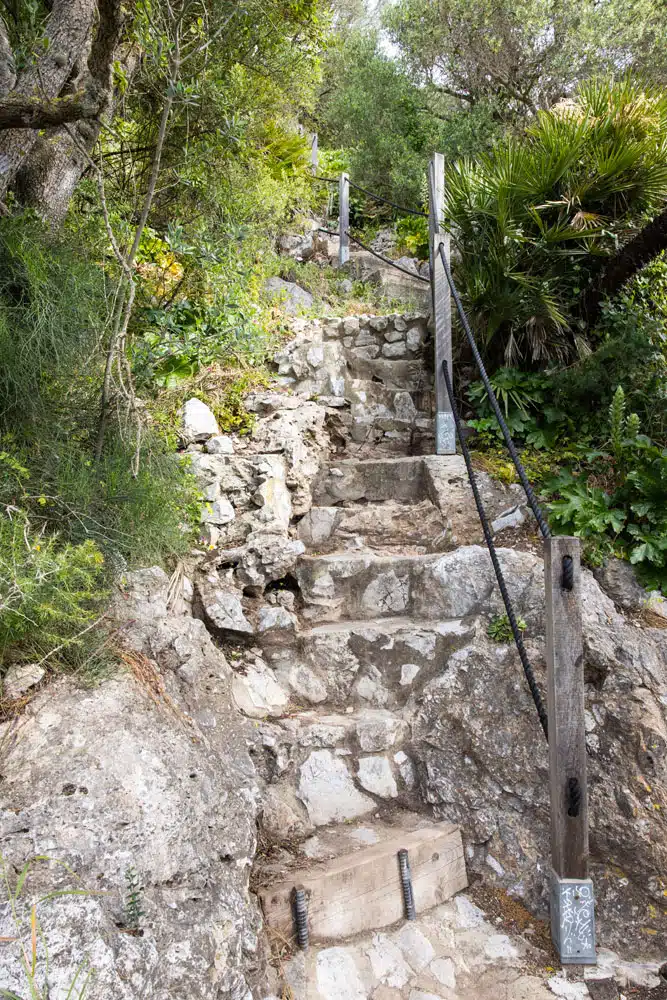
First set of steps.
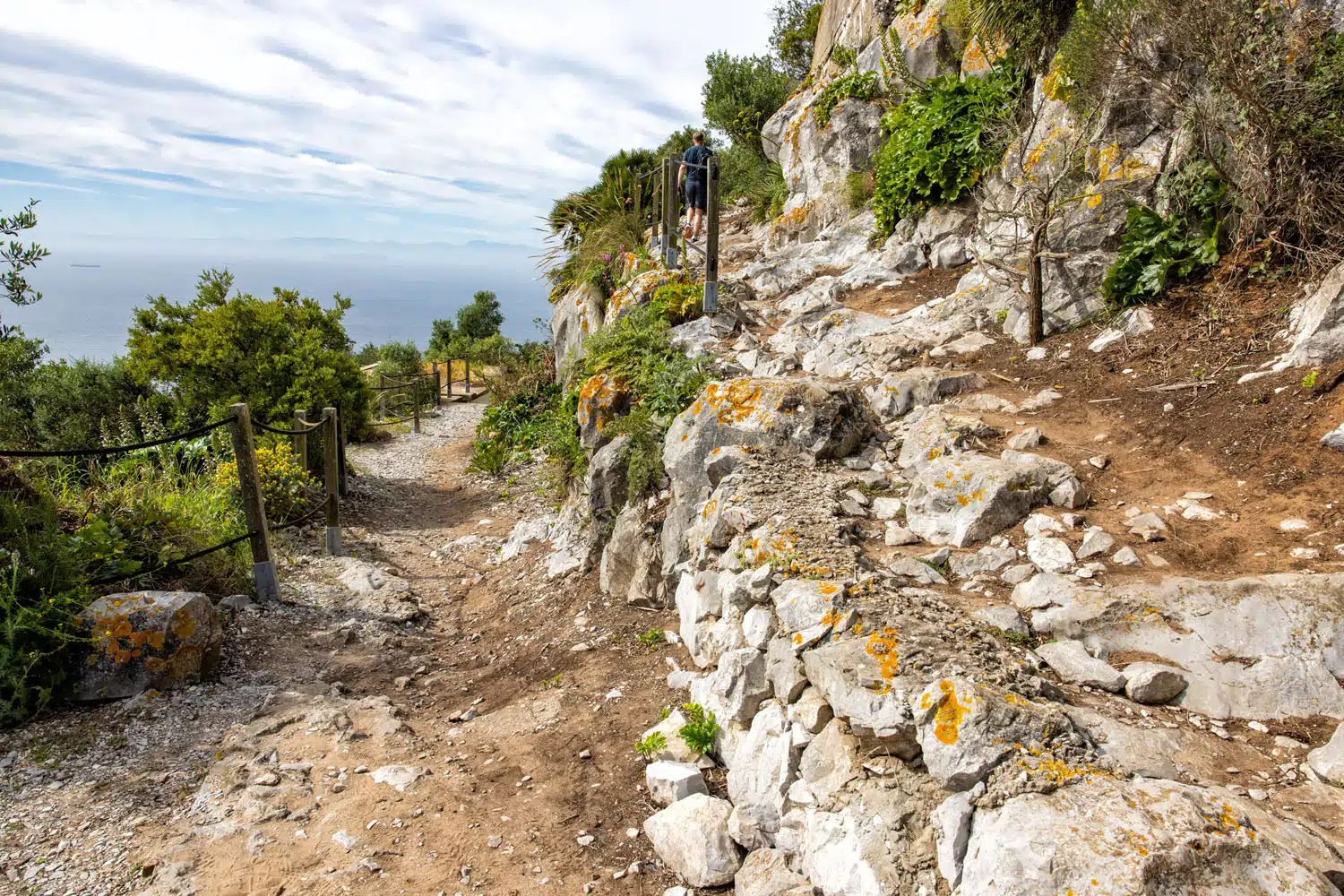
Next is a short walk through a tunnel, followed a few more steps. At the 1 km (0.66 mile) point, you’ll reach the second stair climb. Tim counted about 265 steps here. The bad news is that it is a longer climb and you’ll most likely be hot and bit tired at this point. But the good news is that once you step up that final step, you made it to the top.
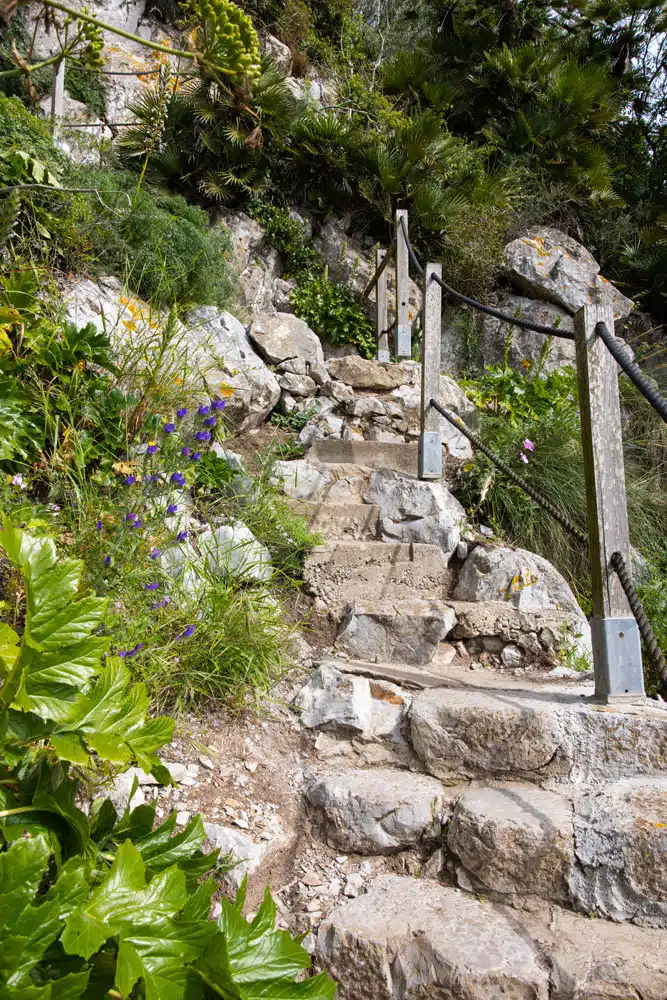
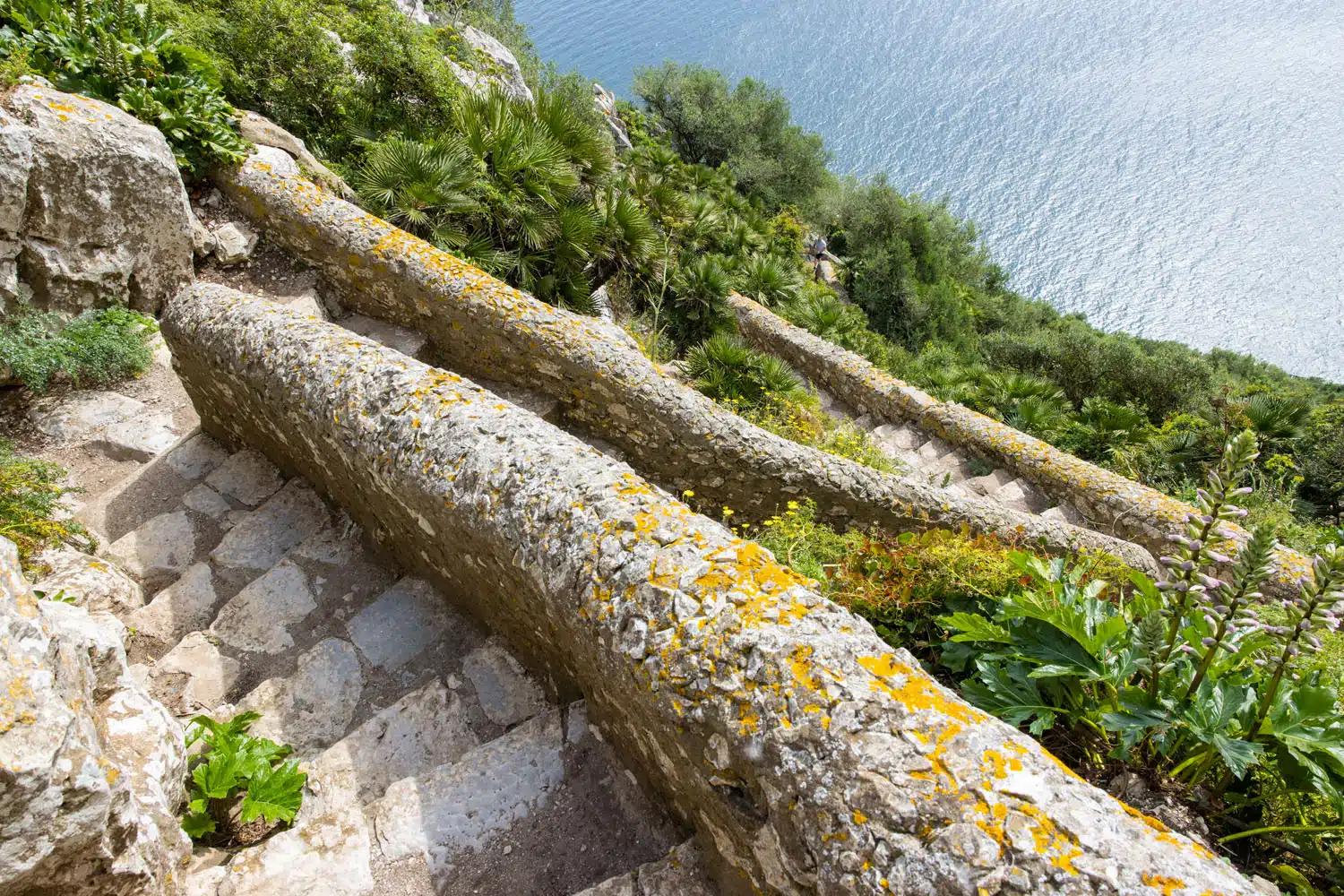
This is the view near the top of the second set of steps.
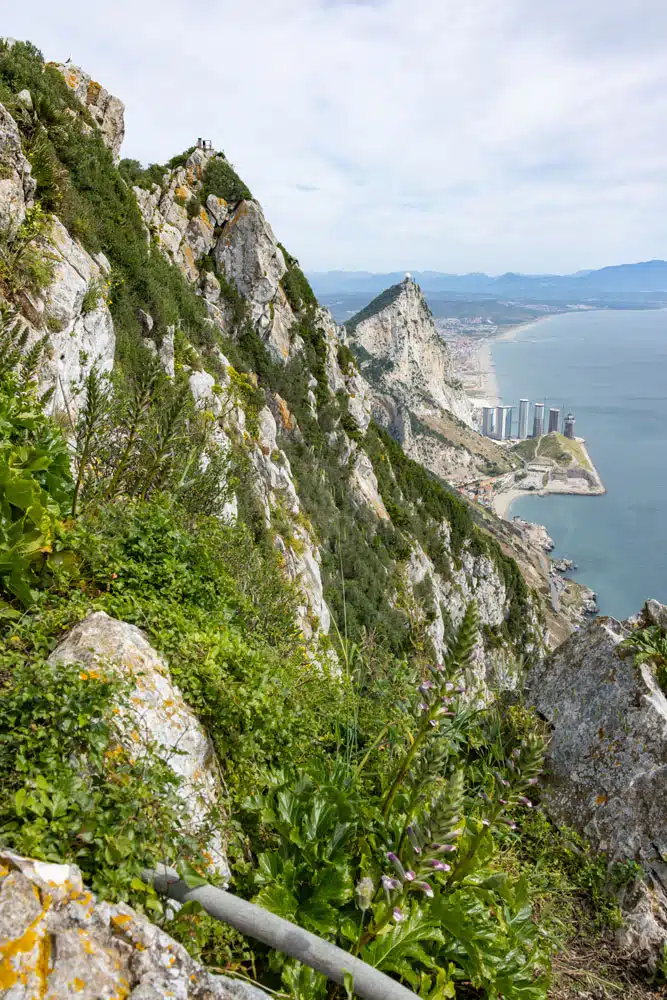
And near the top of the steps, the views really start to get good!
Congratulations! Everything from this point on will be much easier and mostly a downhill walk. Well, except for the next place to visit…
How to Get to the Mediterranean Steps
If you plan to drive and park in Gibraltar, one of the best parking lots is at the bottom station for the cable car. From this lot, it is a 30-minute walk (1.6 km/1 mile) to the trailhead and most of this is uphill, so you’ll already get a workout even before starting the hike. Use Google Maps to route yourself to bottom of the Mediterranean Steps (the route is also marked on our map above).
If you plan to park on the Spanish side of Gibraltar, you can ride local bus 10 or the shuttle (if you prepurchase a ticket to the cable car) to the cable car parking lot and then walk from here.
2. O’Hara’s Battery
For one of the best views of the Rock of Gibraltar, don’t miss O’Hara’s Battery.
Sitting at 426 meters/1,400 feet, it is the highest point of Gibraltar. This was once a strategic lookout station but is now a spot to get a stunning view over Gibraltar, Spain, and the Strait of Gibraltar.
If you just completed the Mediterranean Steps climb, it is a short walk uphill from the end of the steps. You may not be too thrilled about another climb, but this one is short and well worth it for the effort.
If you rode the cable car, it is a 6 minute mostly downhill walk, with a brief uphill section, from the top station.
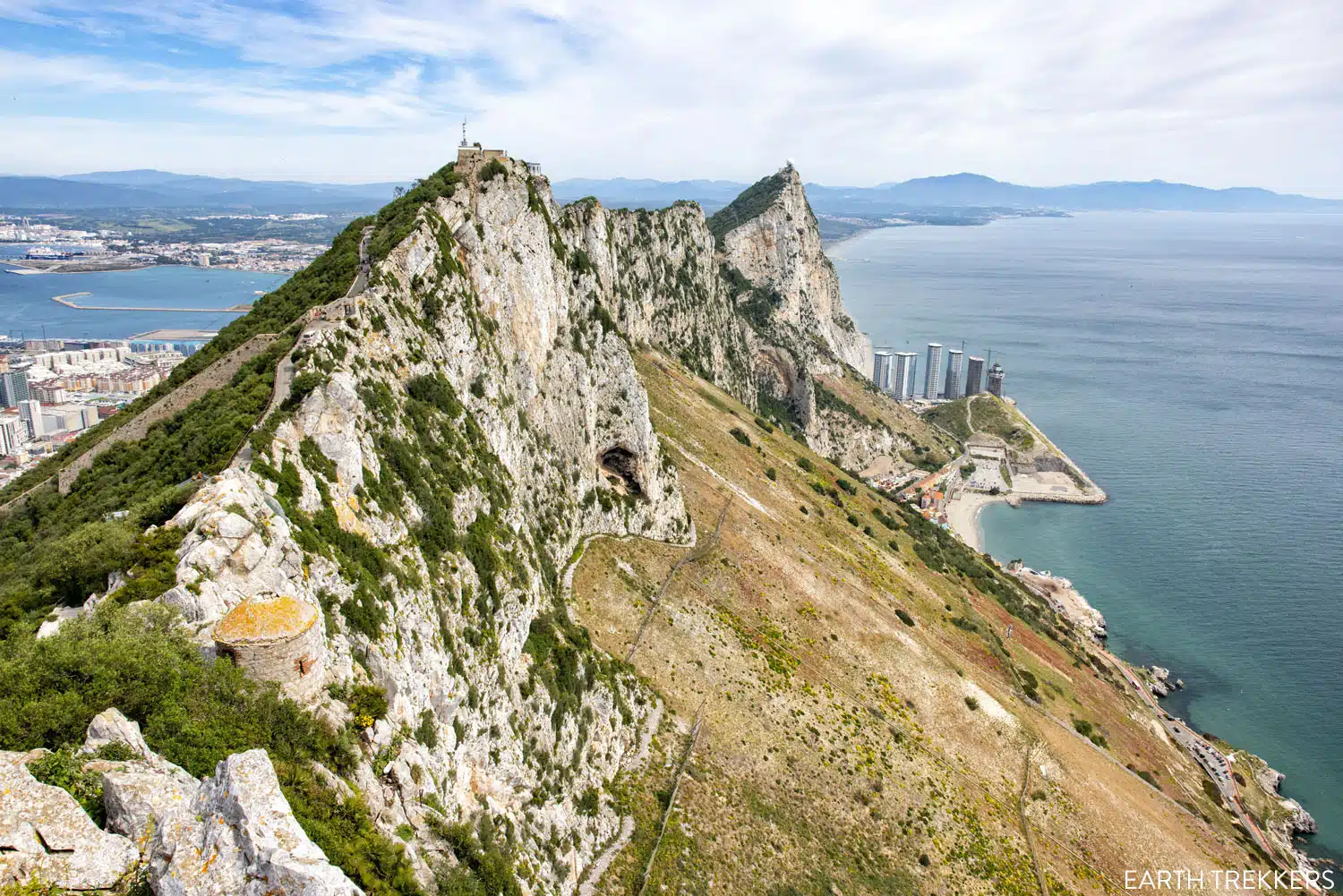
The view from O’Hara’s Battery
3. Douglas Path
A zigzagging maze of wide, asphalt paths (narrow roads) snake down the mountain from the summit to town. From the Mediterranean Steps and O’Hara’s Battery, follow the wide path downhill.
It doesn’t take long until a narrow, dirt trail breaks off to the right. Called the Douglas Path (which is conveniently labeled with a sign), this short trail leads to another viewpoint of the Rock of Gibraltar.
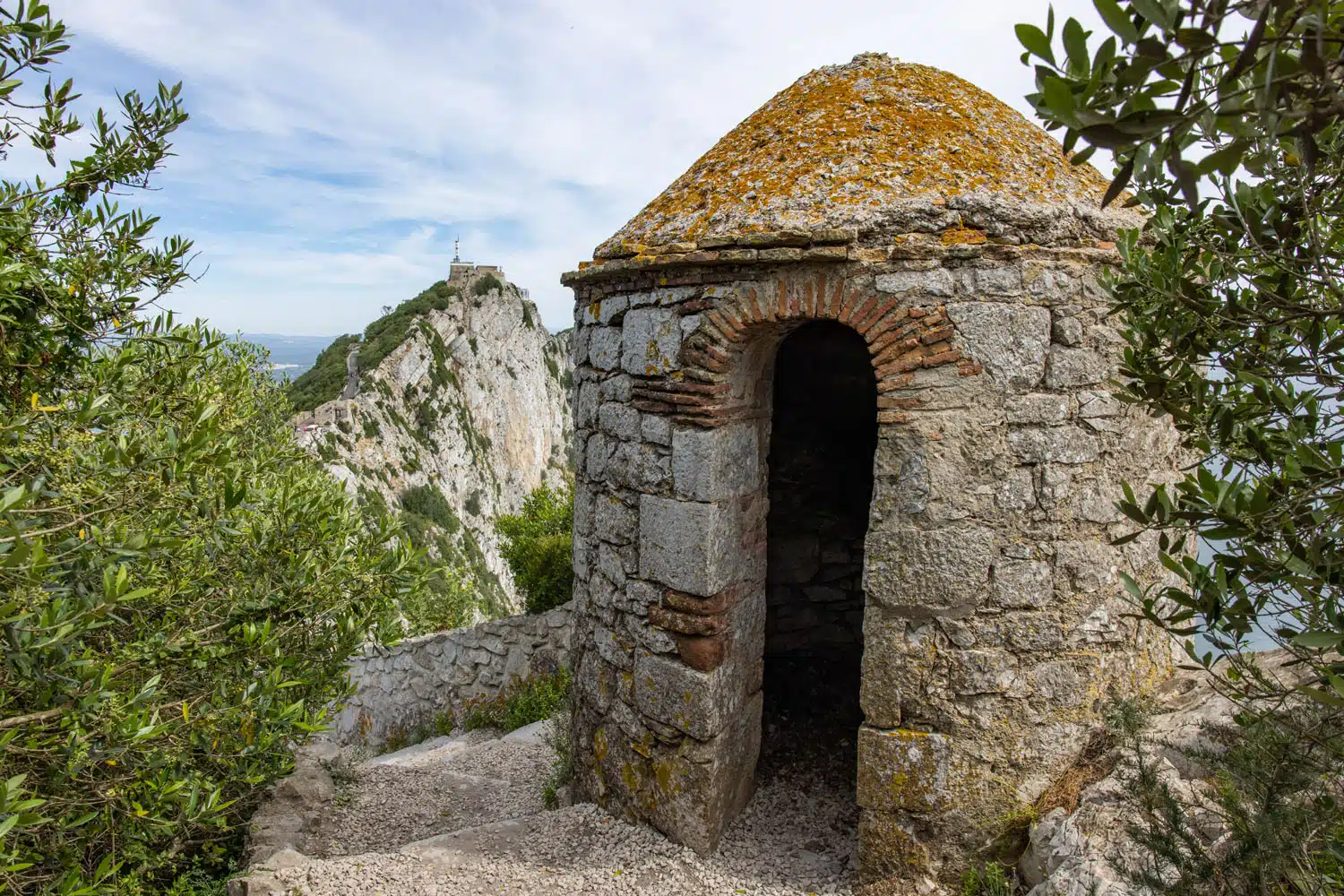
From the viewpoint, you get a view of the west side of the mountain, the town below, and the Bay of Gibraltar. Here’s the view.
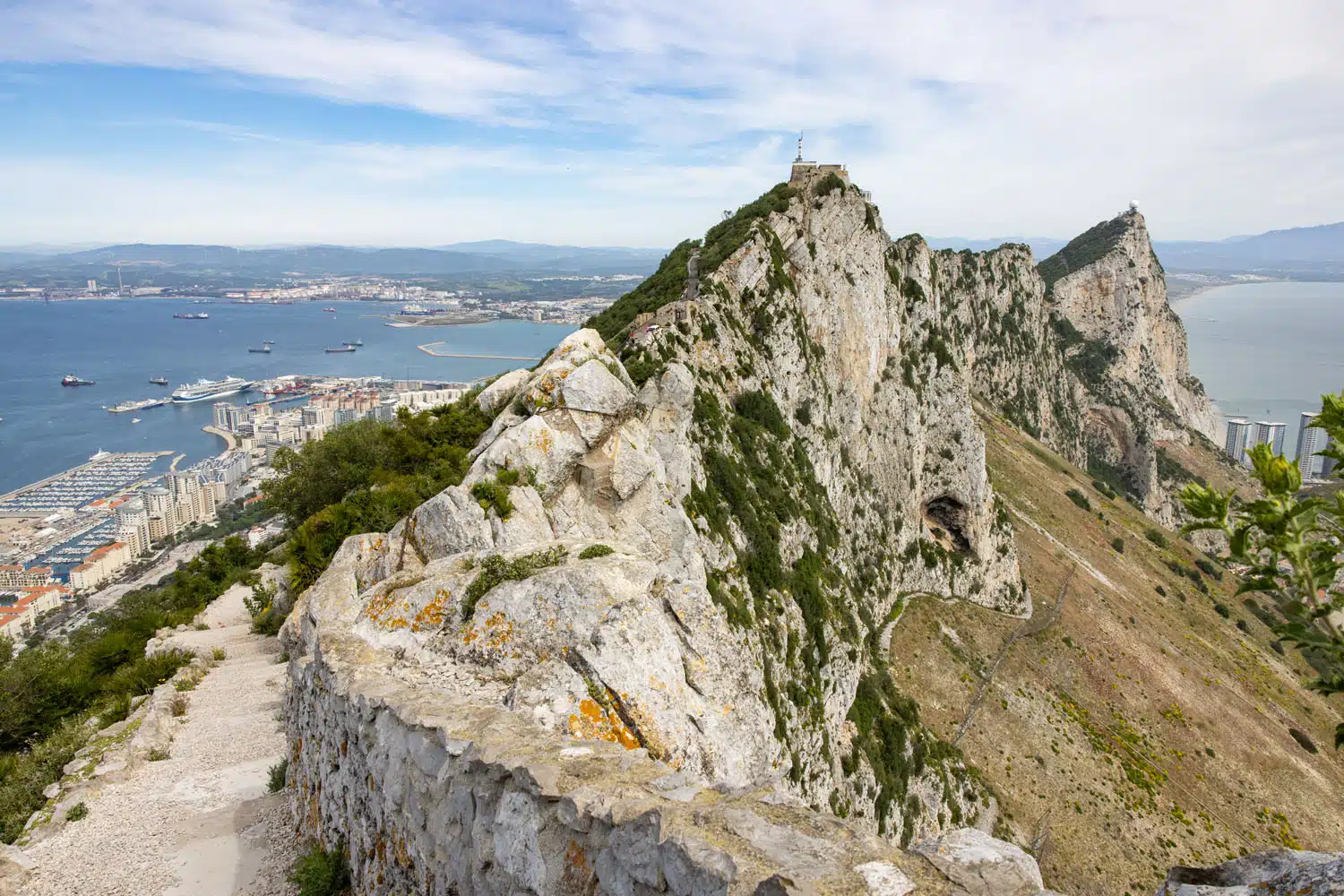
If you climb up onto the rocks next to the viewpoint (be careful!), you get a view of the east side of the mountain. Here’s the view.
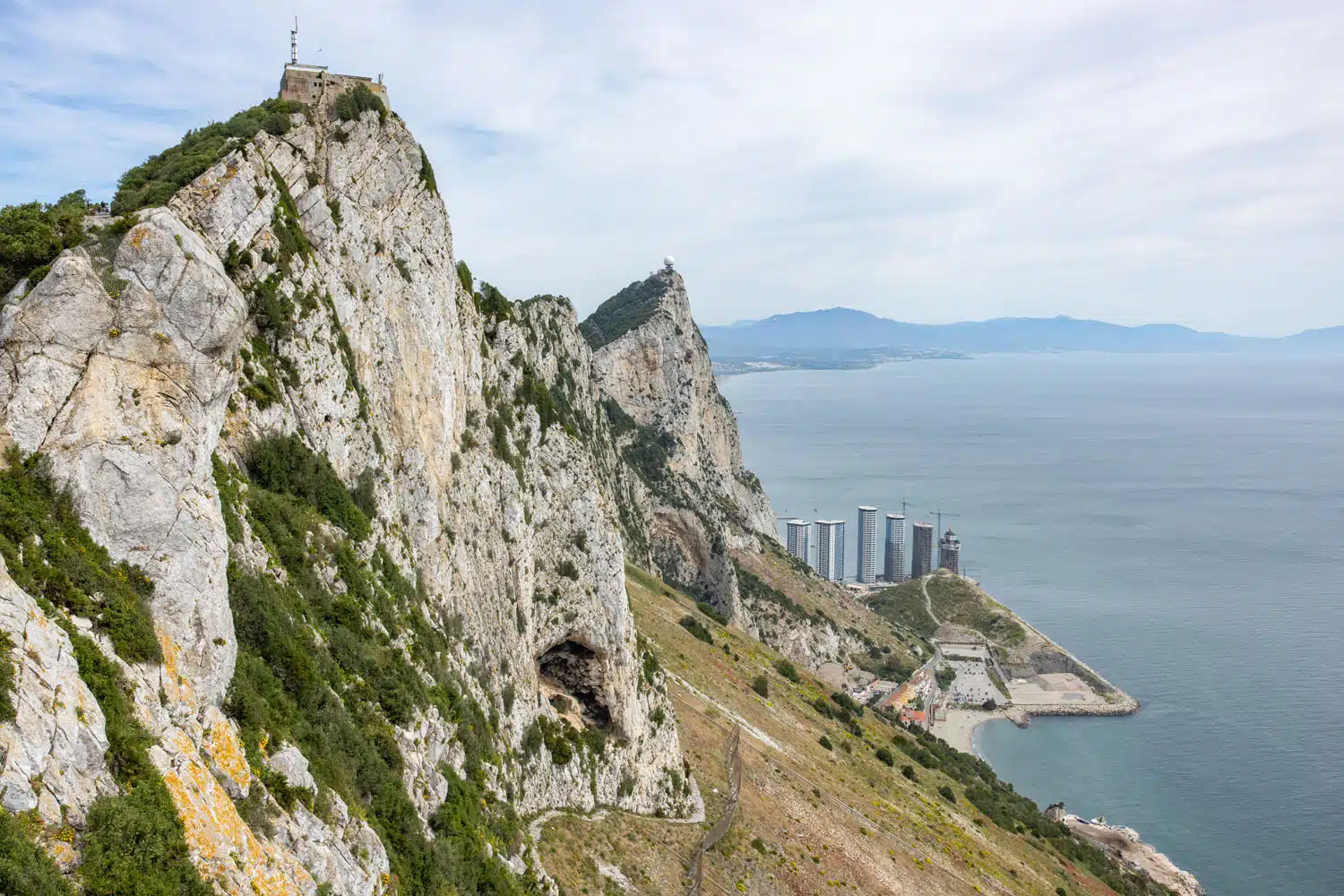
These views are nice but not as good as O’Hara’s Battery or the views from the Mediterranean Steps. This is skippable if you are short on time.
4. The Skywalk
This glass platform was added in 2018. According to the official website, it was opened by Mark Hamill, who played Luke Skywalker.
If you walked the Douglas Trail, continue it downhill and it leads right to the Skywalk. You can also get here from the wider asphalt trail.
5. Saint Michael’s Cave
This cave, with its impressive array of stalactites and stalagmites, has been attracting visitors for well over 2,000 years. A visit here is similar to other caverns around the world, where you ooh and aah at the amazing rock formations. This visit is a bit different, where a colorful lightshow plays on the curtains of rock.
A visit here lasts 15 to 30 minutes.
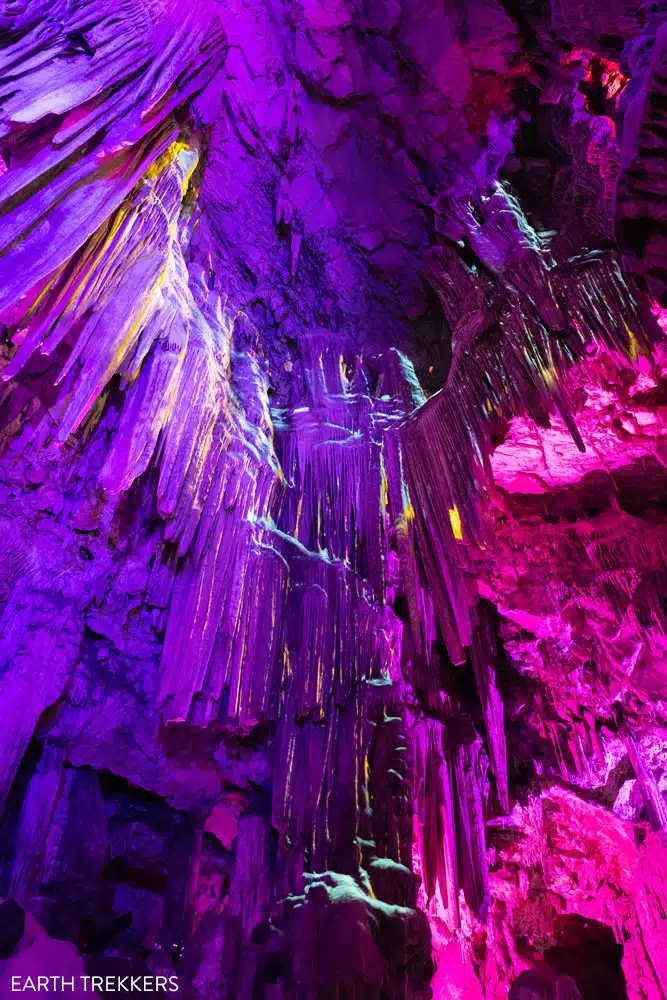
Just outside of the cave is a gift shop and a small restaurant. We ate lunch here. The food is mediocre but it has a handy location and it is a good point to refuel, if you are getting hungry. There are no places to get food between this point and the town, unless you make the steep walk back up to the upper cable car station.
6. Queen’s Balcony
This viewpoint offers another view of the Bay of Gibraltar. It is located lower on the Rock of Gibraltar, so the view is not as good as that from O’Hara’s Battery, but if you are walking to the next few points, you will pass this spot so it’s worth a quick visit to snap a photo or two.
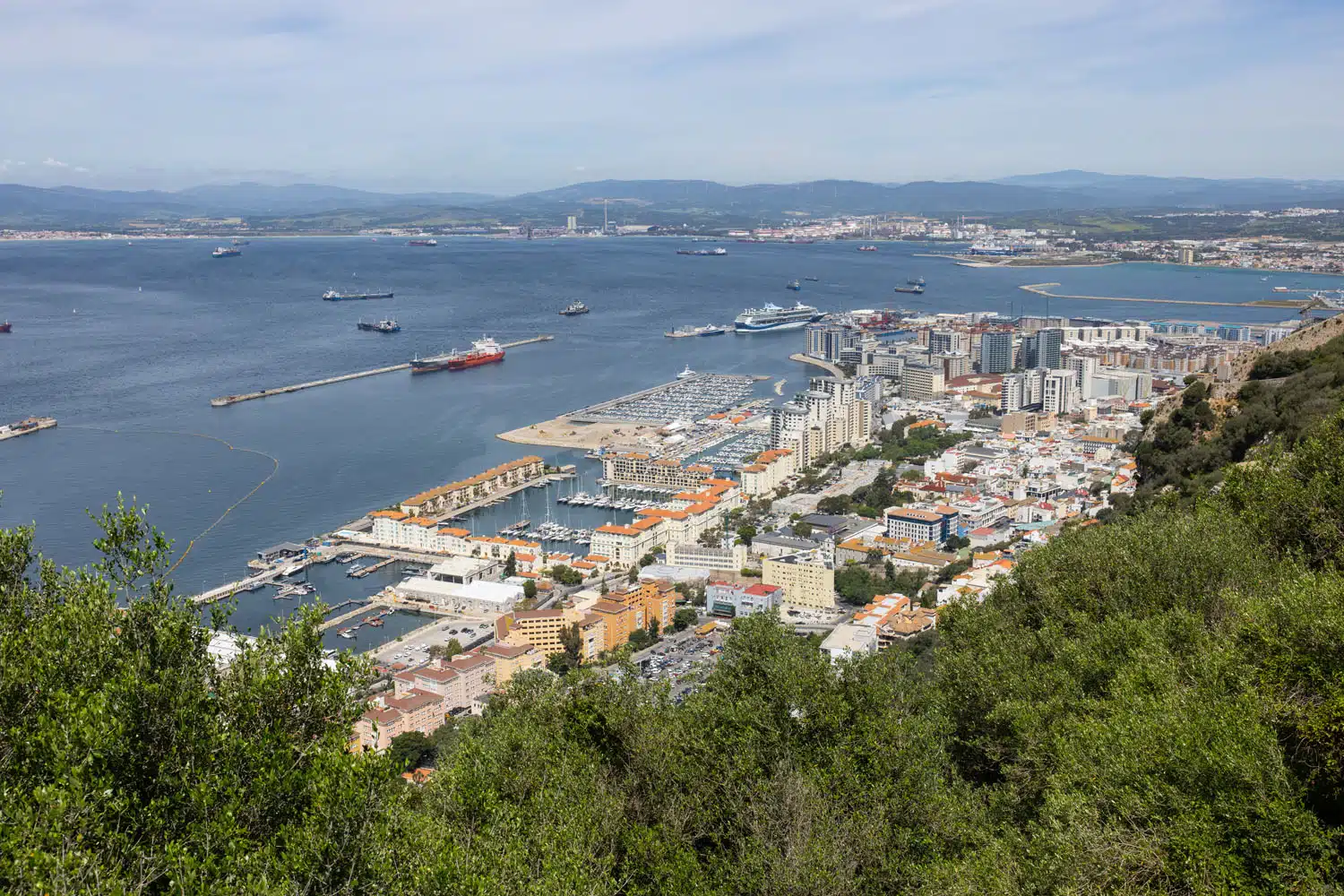
Queen’s Balcony view
7. Windsor Suspension Bridge
This suspension bridge spans 70 meters and offers another great view of the Bay of Gibraltar. For those with a fear of heights, you can walk the trail along the mountain, skipping the bridge. From this path, you can also take a great photo of friends or family on the bridge.
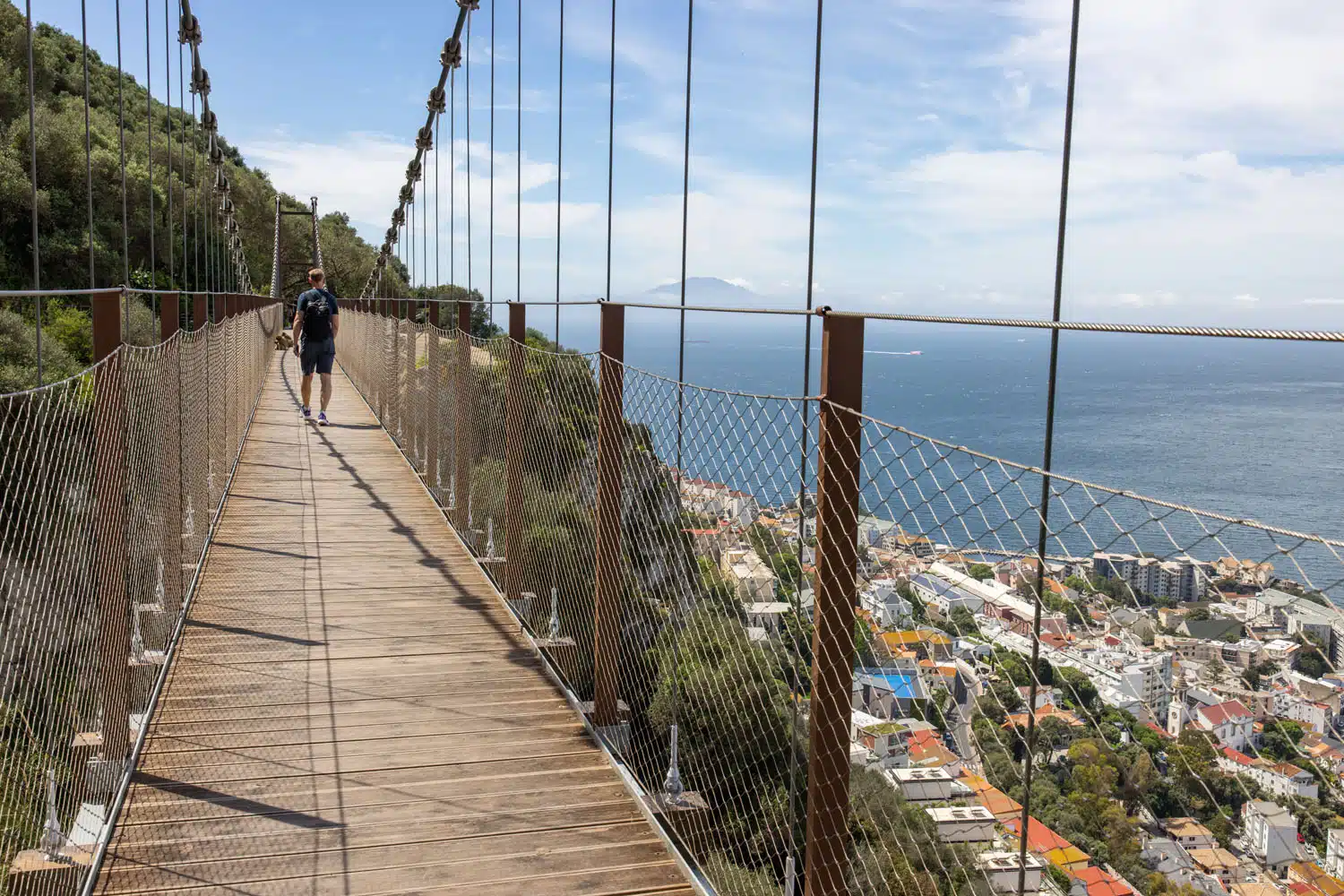
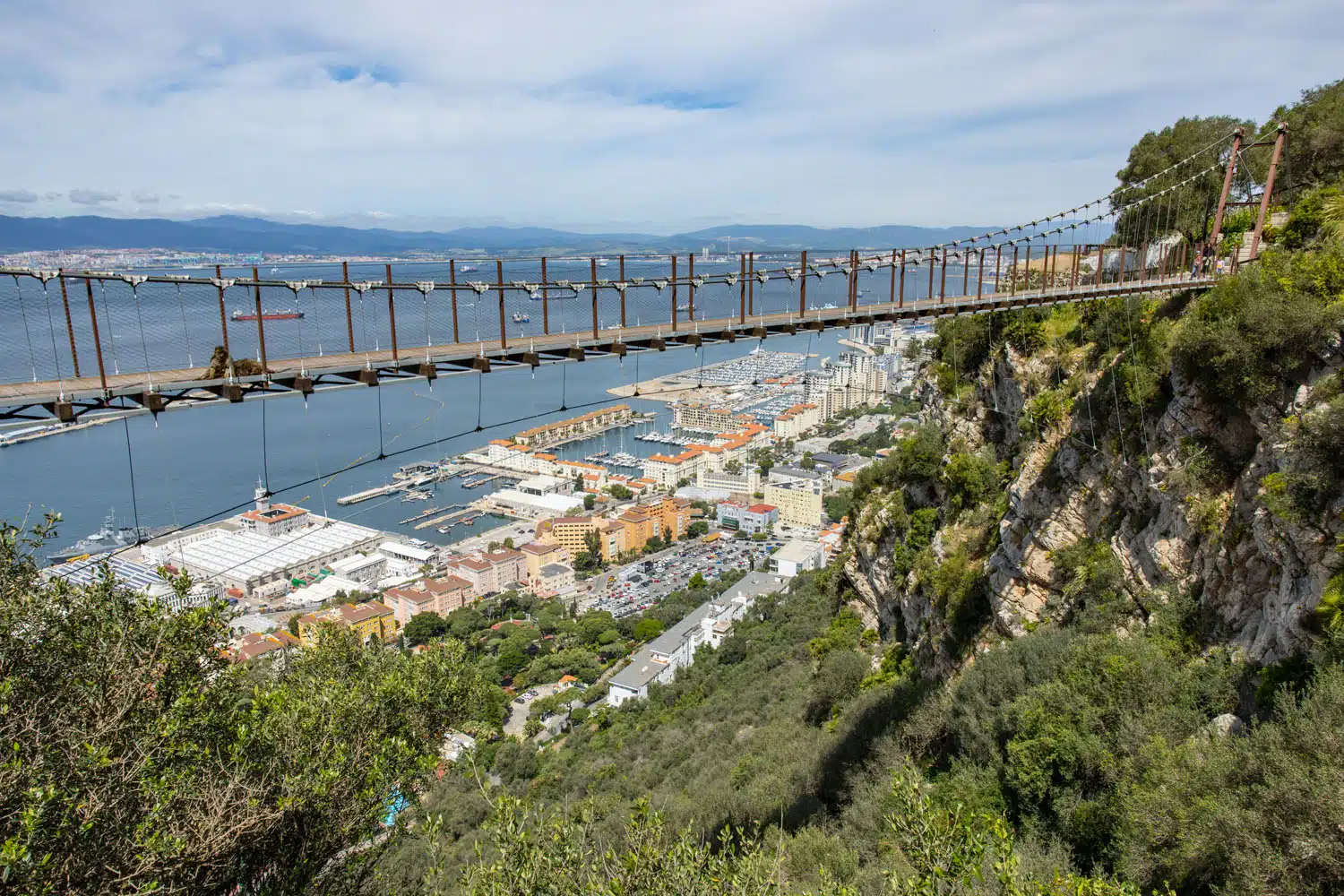
8. Ape’s Den
Continue walking down the asphalt path to the Ape’s Den. At this spot, food is put out for the Barbary macaques. Most likely, as you’ve walked the trails, you’ve already seen quite a few macaques, but this is a great spot to watch them eat, play, and relax.
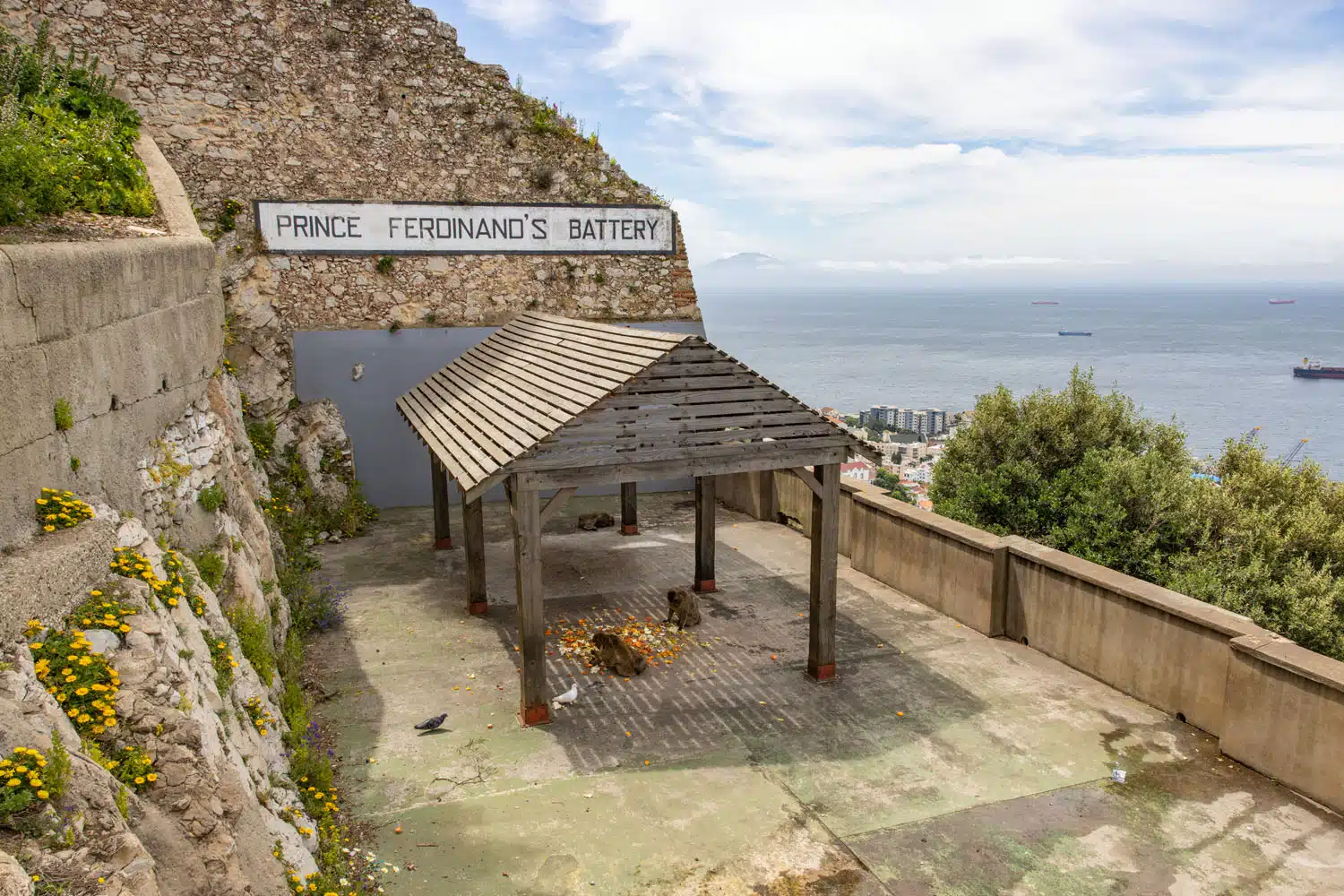
PRO TRAVEL TIP: While visiting the Rock of Gibraltar, do not feed the macaques. This encourages them to seek out food, which can then lead to aggressive behavior towards humans. If you have food on you, make sure it is zipped up in a backpack or purse. If you have a bag of food visible in your bag, or are holding any kind of food, they are not shy about jumping onto you to steal your food. We saw this multiple times while visiting the Rock of Gibraltar.
DECISION POINT: The remainder of the sights on this list require a lot of walking and may not be worth it to everyone. I think these would be worthwhile for those with an interest in history or WWII but skippable if you have no interest. From the Ape’s Den, it is a strenuous 15-minute uphill walk to the top station of the cable car or a 25-minute downhill walk to the lower cable car station and parking lot. There is a middle station but the cable car does not stop here from April through October and even then it will only stop if there is room, so I wouldn’t count on this working.
9. Princess Caroline’s Battery
Armed with several WWII guns, this battery also has a nice view over the town and the Bay of Gibraltar. However, if you walk up to the Great Siege Tunnels, there is a viewpoint that is even better.
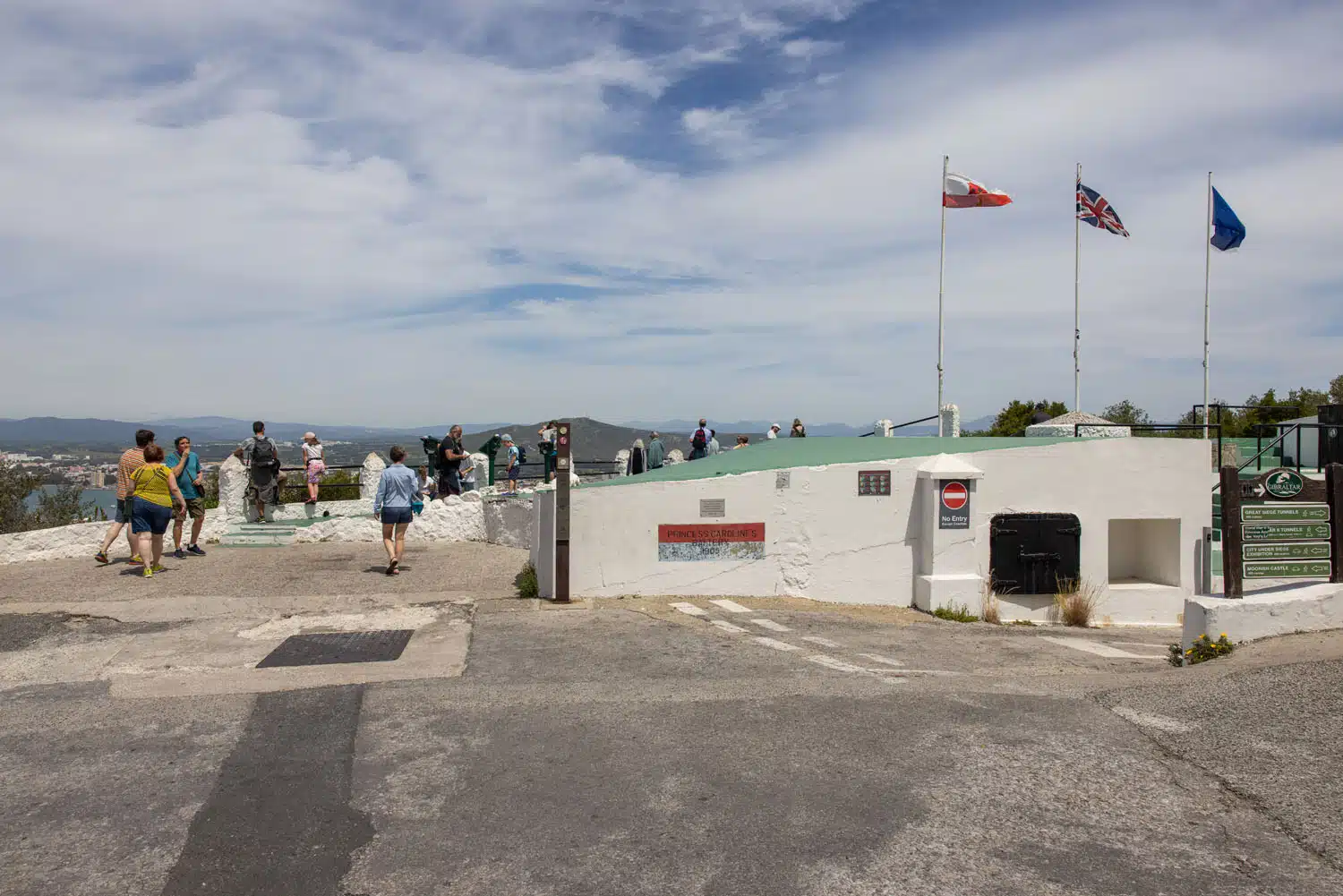
10. Great Siege Tunnels
From Princess Caroline’s Battery, it is a 400-meter uphill walk to the Great Siege Tunnels (you will pass toilets on this walk).
The Great Siege Tunnels were built by the British during the Great Siege of Gibraltar, which started in 1779 and lasted almost 4 years. You will walk through the tunnels and learn the history on the informational signs.
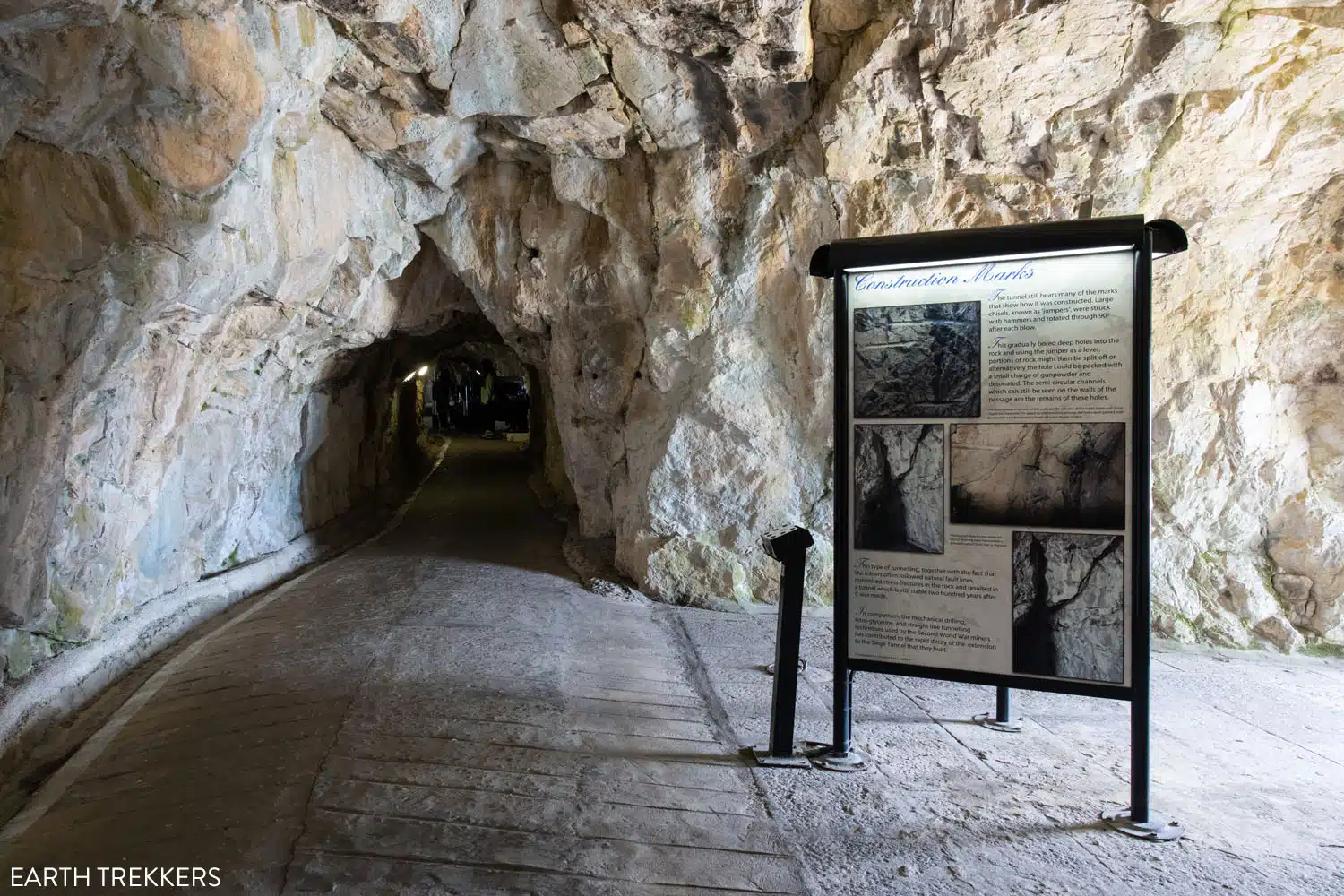
Just outside of the entrance to the tunnels is yet another great view over Gibraltar and Spain.
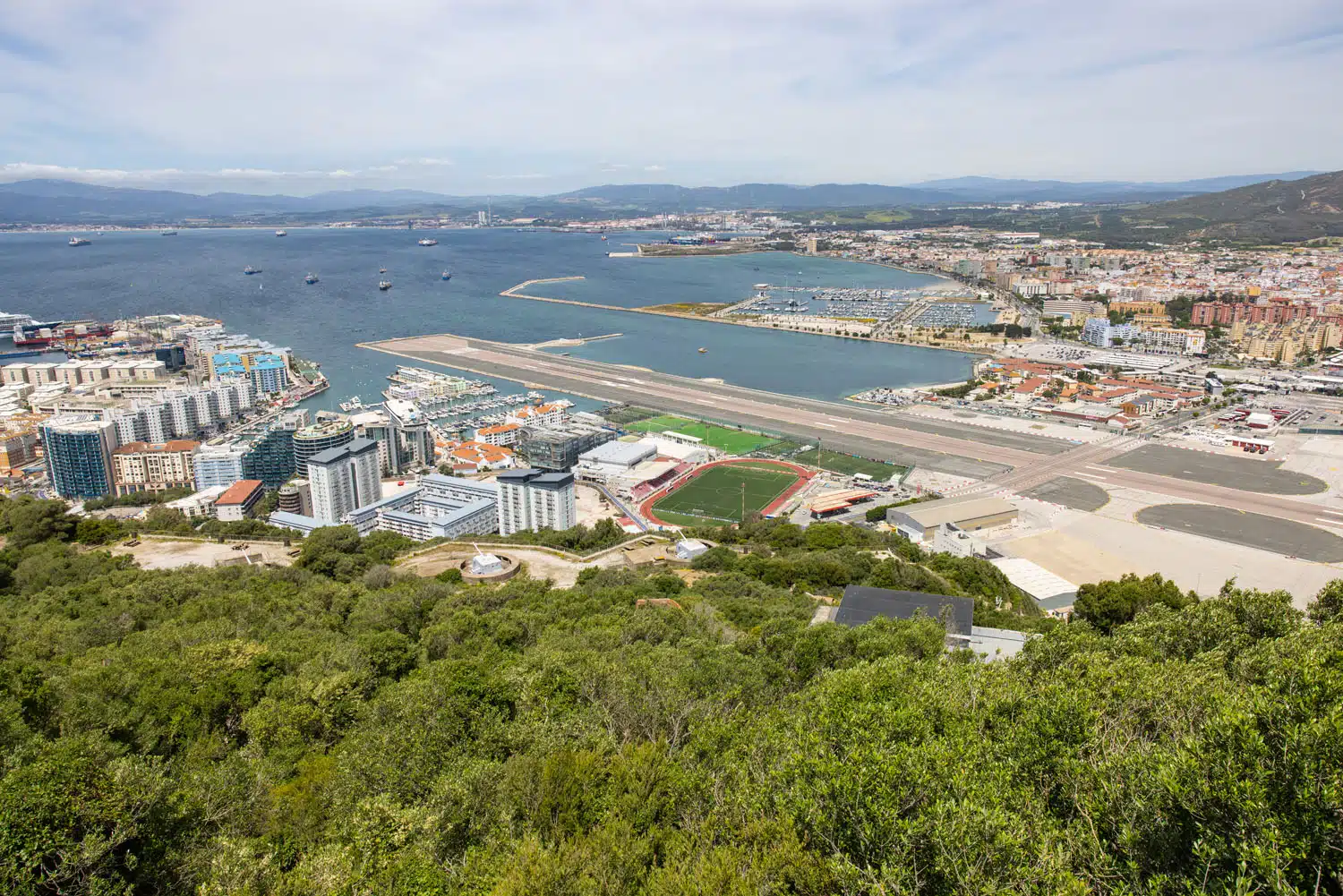
11. World War II Tunnels
A short walk downhill from the Great Siege Tunnels are the World War II Tunnels. You can walk through the tunnels unguided or take a tour to see where Eisenhower and Churchill worked together to plan the invasion of North Africa. You can set up a tour by contacting ur&beaches@gibraltar.gov.gi.
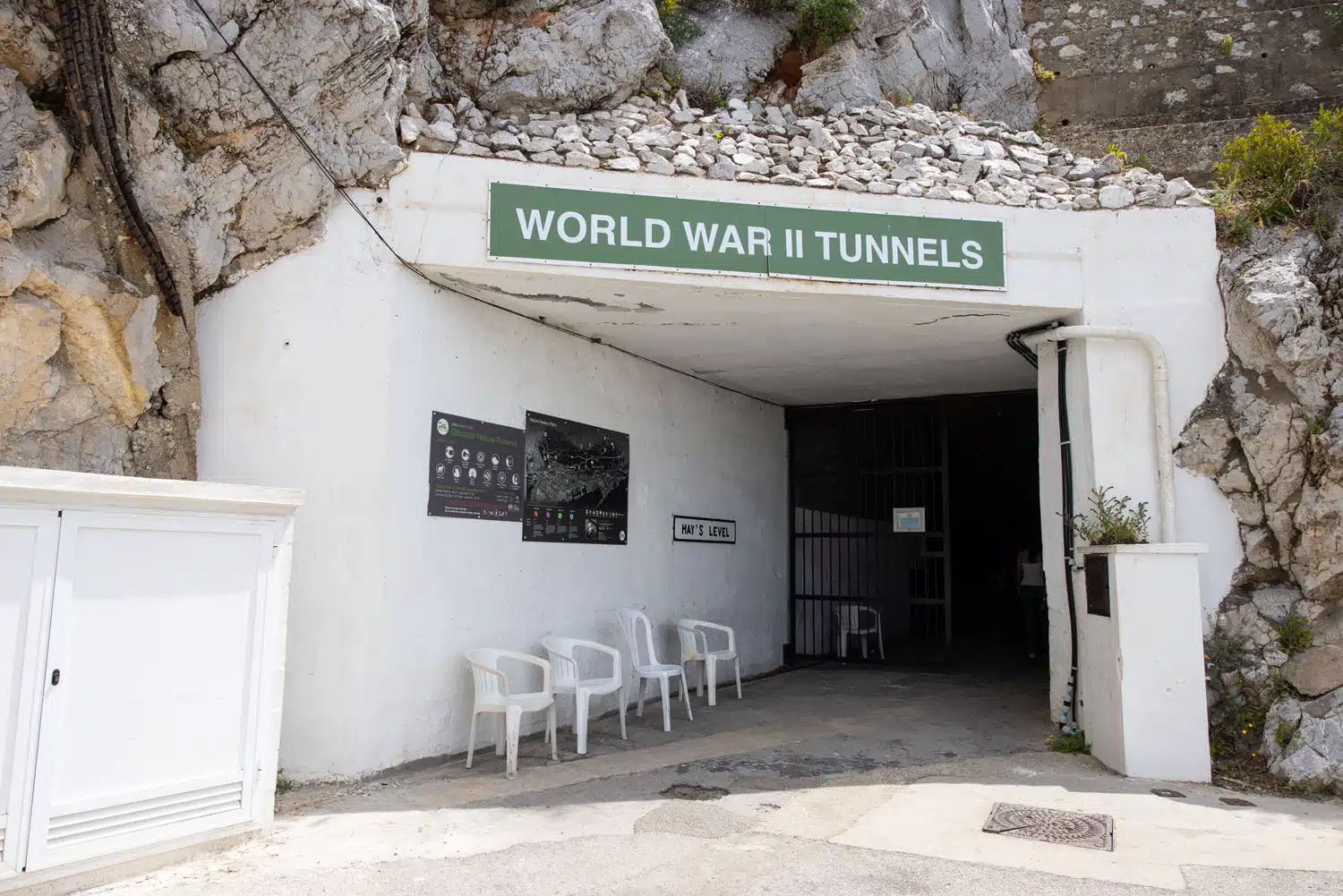
12. The Moorish Castle
The final place to visit on the Rock of Gibraltar is the Moorish Castle. The original Moorish Castle was built in 1160 AD and then destroyed by the Spanish in the early 14th century. The ‘Tower of Homage’ was rebuilt later in the 14th century by Abu-I-Hasan. On a visit here, you can climb to the top of the tower for the view but it doesn’t compare to the viewpoints already listed.
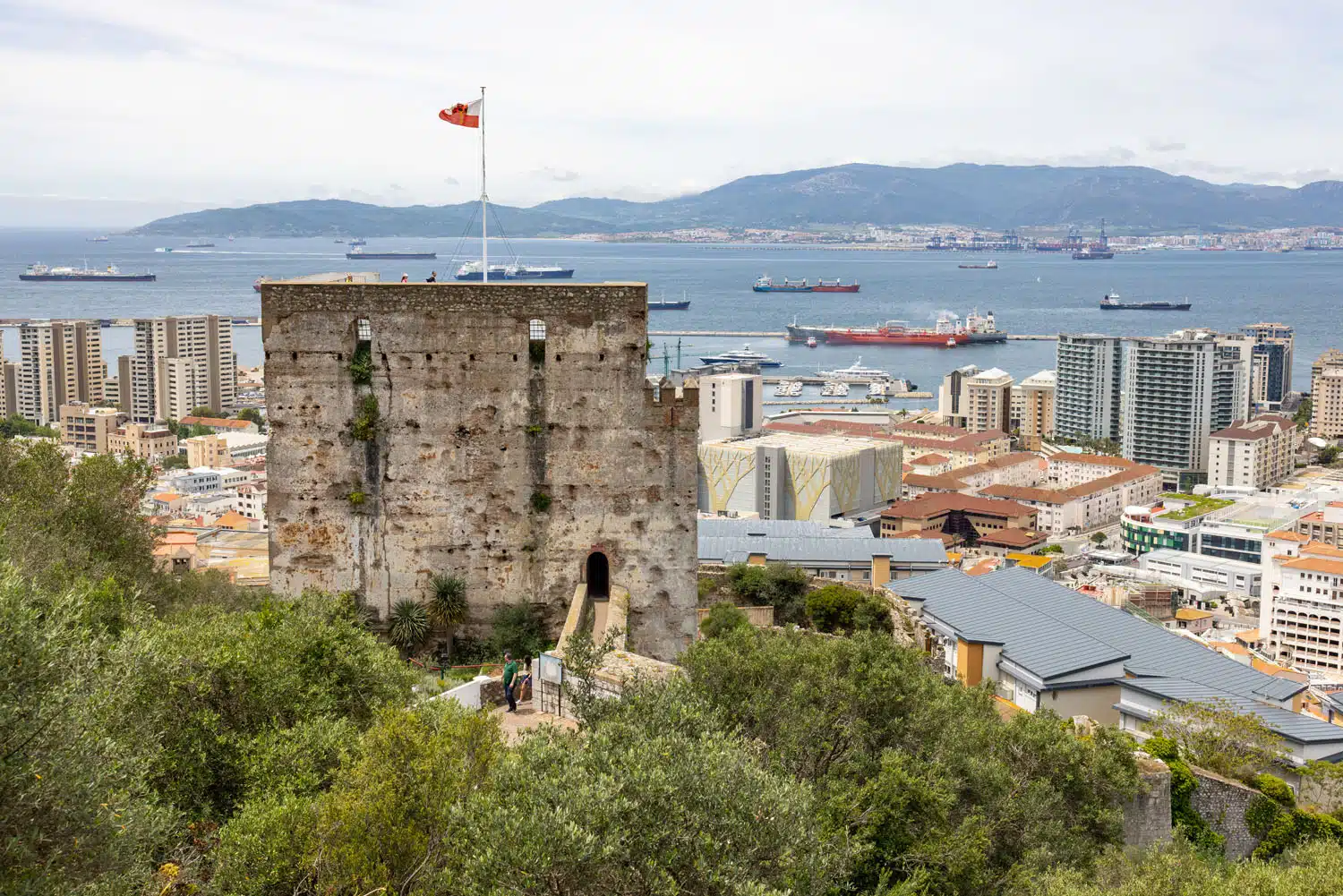
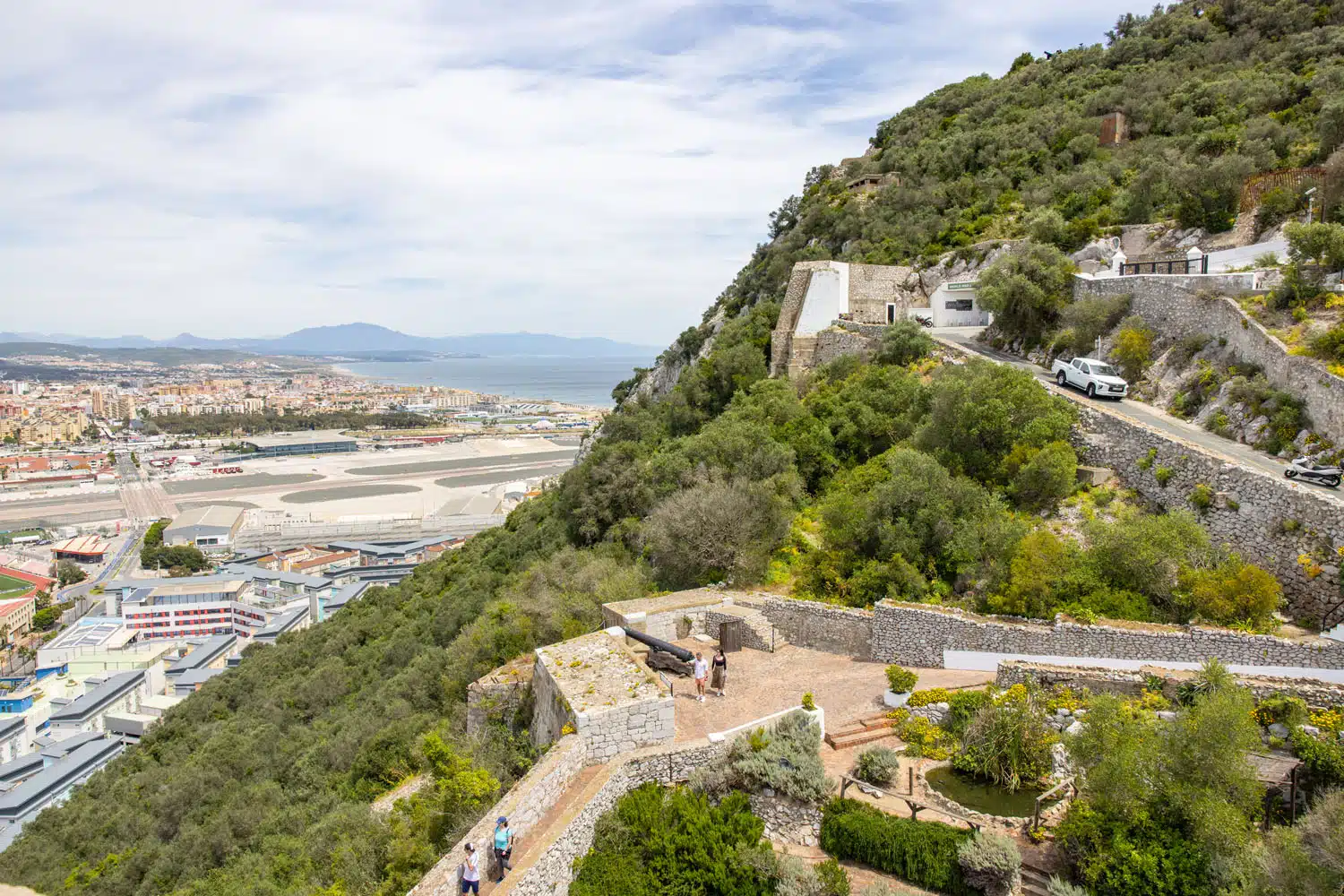
View from the Moorish Castle
Tickets to the Rock of Gibraltar Nature Preserve
To visit all of the places listed above, you will need to purchase a Nature Reserve Ticket. This can be purchased at the cable car stations, at the bottom entrance of the Mediterranean Steps, at the Moorish Castle, and at Devils Gap.
Online, you can purchase a ticket. According to the official website, you will present this receipt at one of the ticket offices to get your ticket.
A ticket is a wrist band with a QR code. The wrist band is scanned at turnstiles to enter the sites listed above.
The Nature Reserve ticket is separate from the cable car ticket.
For updated pricing and more information, visit the official website.
How to Get to the Rock of Gibraltar
There are several ways to get to the Rock of Gibraltar: on foot, by cable car, by taxi, or on a private tour.
On foot, you can walk out to the Mediterranean Steps, hike up to the top of the Rock, and then work your way down the mountain, visiting the sites listed above. This is what we did, which amounted to 13 km/8 miles of walking over the course of the day (this includes the walk to and from the cable car parking lot).
Another option is to ride the cable car to the top station, visit the sites of most interest to you, and walk or ride the cable car to the bottom station. The cable car runs all year, with different summer and winter hours. Get updated hours, pricing, and purchase your tickets on the official website.
It is also possible to book a private tour. You will travel the Rock in a van, which saves you lots of walking up and down hills. It’s a great option for those with limited mobility.
Should You Drive and Park in Gibraltar?
If you have a rental car, you have two options. You can drive into Gibraltar and park at the bottom station of the cable car or a nearby lot. Be aware that you are entering a British Overseas Territory, so you will need your passport and you will go through passport control. There can be very long lines at peak travel times.
Parking in Gibraltar
The official website states that finding a parking space can be challenging.
We had a rental car and visited Gibraltar on a Sunday in early May. In our experience, there was no line to get through passport control, at the beginning and end of our visit, and parking also was not an issue. But during the summer months, when visitation is higher, parking could be an issue.
Even though this is a British territory, you will still drive on the right.
As for parking, you need to make sure you are parking in the correct type of spot. Here is an overview:
- Parking spaces with white lines: Free parking
- Parking spaces with blue lines: Paid parking (make sure you pay at the kiosk and display the ticket on your dashboard)
- Parking spaces with yellow lines: Residential parking only (do NOT park here)
Don’t violate the parking rules. The parking lots are monitored and the police will attach a boot to your tire or have your car towed.
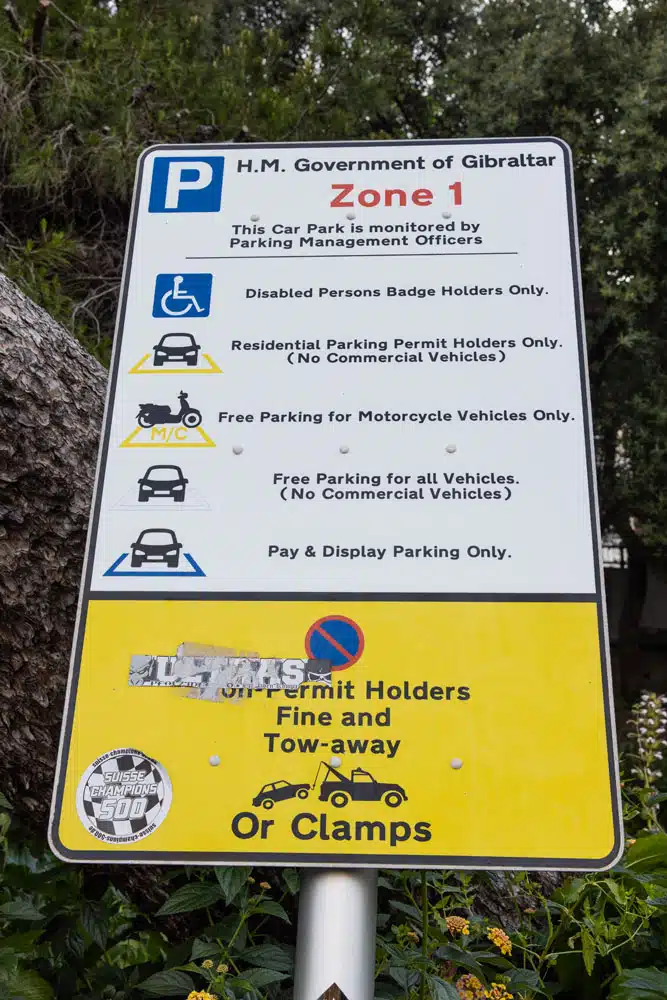
Where to Park:
- 1st Choice: Cable Car parking lot
- 2nd Choice: 2 Queensway Road Parking Lot (a 5-minute walk to the bottom cable car station)
Parking in Spain
Since we did not do this, I’m not sure exactly how this works. There is a parking lot in Spain and from here, you can take a complimentary shuttle to the cable car station. There are a lot of specifics about this, but you can read more on the official website (scroll down to the Practical Information section).
How Much Time Do You Need on the Rock of Gibraltar?
You need a half to a full day to do most or all of what is listed above.
Our visit lasted 4 hours, which includes the walk from the parking lot to the Mediterranean Steps, the hike, all of the sites listed above, and the walk back to our car. However, we move very fast (we did the Mediterranean Steps in 30 minutes) and moved rather quickly through the tunnels and Moorish Castle. We also did not encounter any lines at any of the sites. If you want to do a similar itinerary (which I’ll get to below), plan on spending 4 to 6 hours on the Rock of Gibraltar.
WHAT WE DID: We visited the Rock of Gibraltar on a day trip from Tarifa, Spain. We spent two full days in Tarifa, using one day to visit Gibraltar and the second day to day trip to Tangier, Morocco. This was part of a bigger trip through Andalusia, Spain, where we also visited Seville, Córdoba, Granada, Ronda, and walked the Caminito del Rey.
One Day on the Rock of Gibraltar: Active & Adventurous
This first itinerary is listed exactly how we visited the Rock of Gibraltar.
Start at the parking lot for the cable car, whether you parked here or took a bus, taxi, or shuttle here. Walk to the bottom of the Mediterranean Steps, using the route on Google Maps or another map app. This takes about 30 minutes with a distance of 1.8 km.
Purchase your ticket and hike up the Mediterranean Steps. The ticket booth opens around 9:30 am. Allow 30 to 60 minutes.
Enjoy the view from O’Hara’s Battery. Walk downhill (yay!) and take the Douglas Path to the Skywalk. From the Skywalk, continue downhill and visit St. Michael’s Cave. Have lunch or a snack at Saint Michael’s Cabin.
Continue downhill, to the Queen’s Balcony, Windsor Suspension Bridge, and Ape’s Den.
Now you have a choice to make. From here, it is a 20-minute, mostly flat walk to the Great Siege Tunnels. Continue to the WWII Tunnels, Moorish Castle, and walk to the cable car parking lot. OR, from the Ape’s Den, it is a 15-minute uphill walk to the top station of the cable car, which you can ride down to the parking lot.
There are plenty of signs along this route directing you where to go. But the nice thing about doing it this way is that once you make it to O’Hara’s Battery, the majority of the walk will be downhill for the rest of the day.
As an alternative, you can do this exact itinerary in the opposite direction, ending with the hike down the Mediterranean Steps.
One Day on the Rock of Gibraltar: Highlights with Less Walking
If you want to visit the top sights without doing a challenging hike or 13 km/8 miles of walking, here is what we recommend.
Ride the cable car to the top station.
Walk to O’Hara’s Battery. This takes about 6 minutes and the final portion of the walk will be uphill but nothing too strenuous.
Then walk the Douglas Trail, visit the Skywalk, and Saint Michael’s Cave. You could turn around here and return to the upper cable car station, or continue downhill to the Queen’s Balcony, Windsor Suspension Bridge, and Ape’s Den, and then walk up to the upper cable car station from here (a 15-minute uphill walk or directly down to the parking lot (a 25-minute downhill walk).
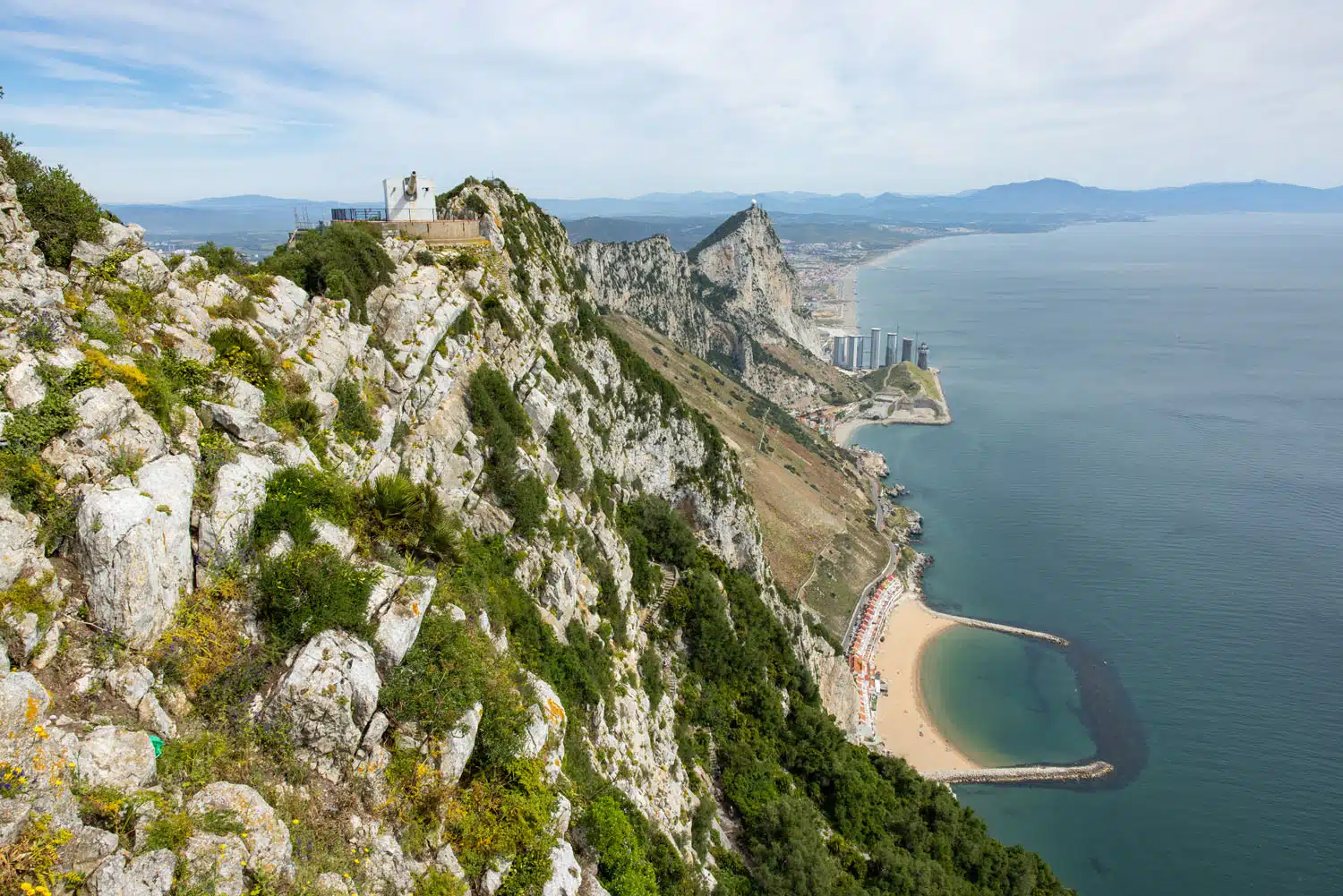
Tours of Gibraltar
On this tour, cruise the Strait of Gibraltar to spot dolphins and then ride the cable car to the top of the Rock.
If you are staying in Seville, this day trip includes a few sights in Gibraltar as well as a few highlights on the Rock of Gibraltar.
This short tour includes Europa Point, St. Michael’s Cave, and the Apes Den to see the Barbary macaques.
Frequently Asked Questions
Is the Rock of Gibraltar worth it?
With its hiking and walking trails, caves filled with stalactites and stalagmites, glass platform, incredible views, Barbary macaques, Moorish Castle, and war tunnels, the Rock of Gibraltar is filled with wonderful surprises. There is something here for all ages and well worth the visit.
What are the top things to do on the Rock of Gibraltar?
The best things to do on the Rock of Gibraltar are seeing the Barbary macaques, enjoying the view from the cable car, hiking up or down the Mediterranean Steps, touring the war tunnels, and exploring Saint Michael’s Cave.
How much time should you spend on the Rock of Gibraltar?
Plan on spending a half to a full day on the Rock of Gibraltar, to fully experience the Nature Preserve, hike a trail or two, see the macaques, and explore the war tunnels and underground caverns.
Can you climb to the top of the Rock of Gibraltar?
Yes, there is a hiking trail that leads to the top of the Rock of Gibraltar. Called the Mediterranean Steps, this trail is 1.9 km/1.2 miles long with 400 meters/1330 feet of total ascent and is rated as challenging.
Why is the Rock of Gibraltar famous?
According to Greek legend, the Rock of Gibraltar was one of the two Pillars of Hercules. This limestone monolith is also an important strategic position on the Strait of Gibraltar and numerous battles and sieges have been fought here.
If you have any questions about how to visit the Rock of Gibraltar, or if you would like to share your experience, let us know in the comment section below.
More Information for Your Trip to Spain
We have TONS more information about Spain in our Spain Travel Guide, including Barcelona, Madrid, Seville, Andalusia, and the Rioja Wine Region.

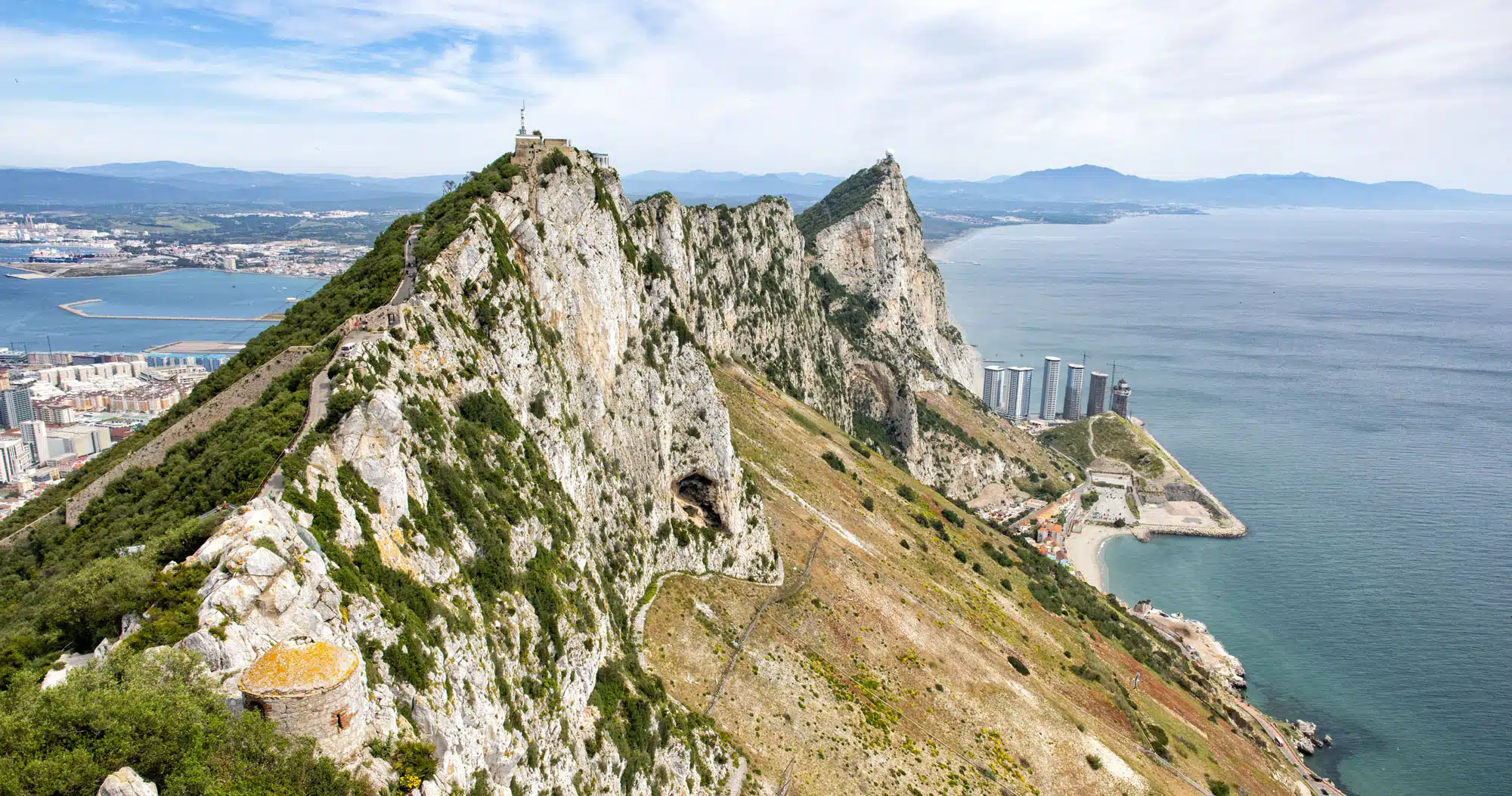

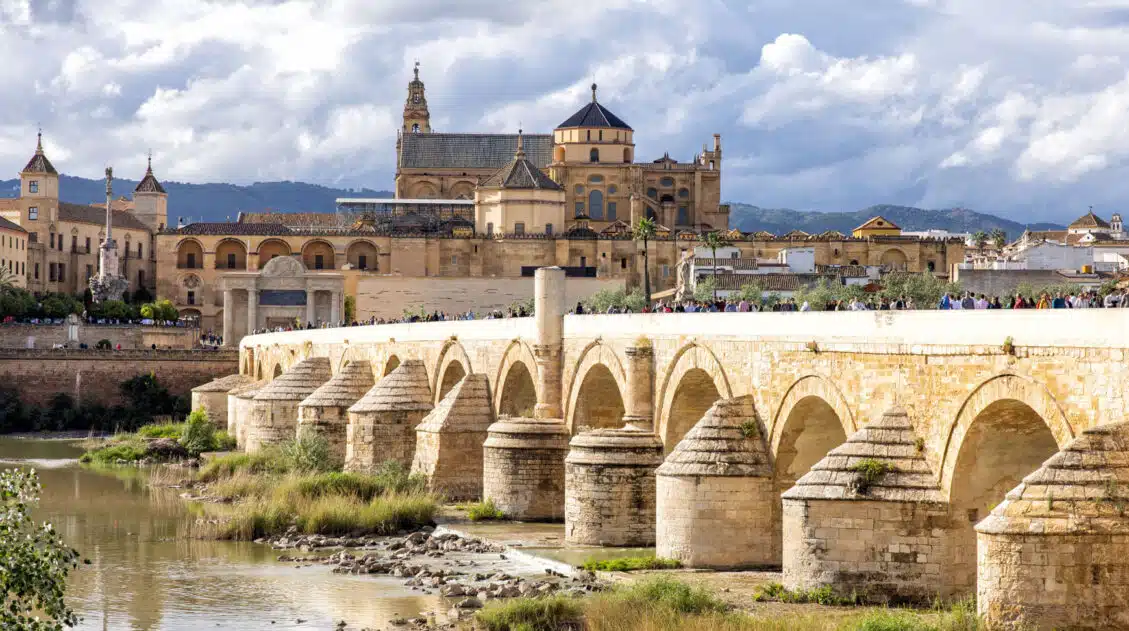
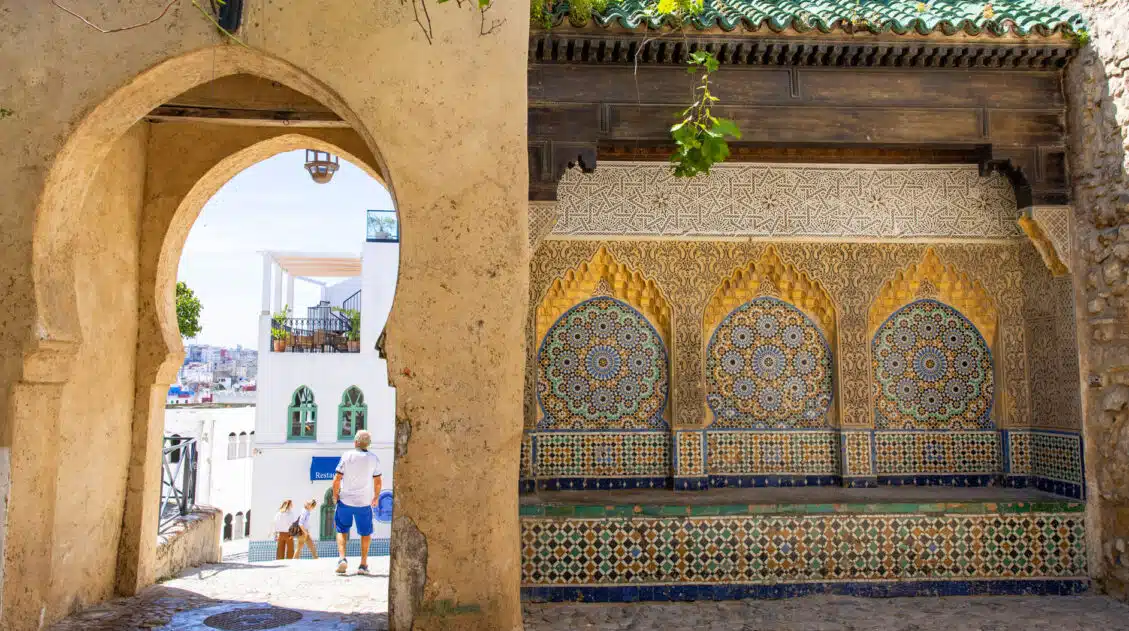
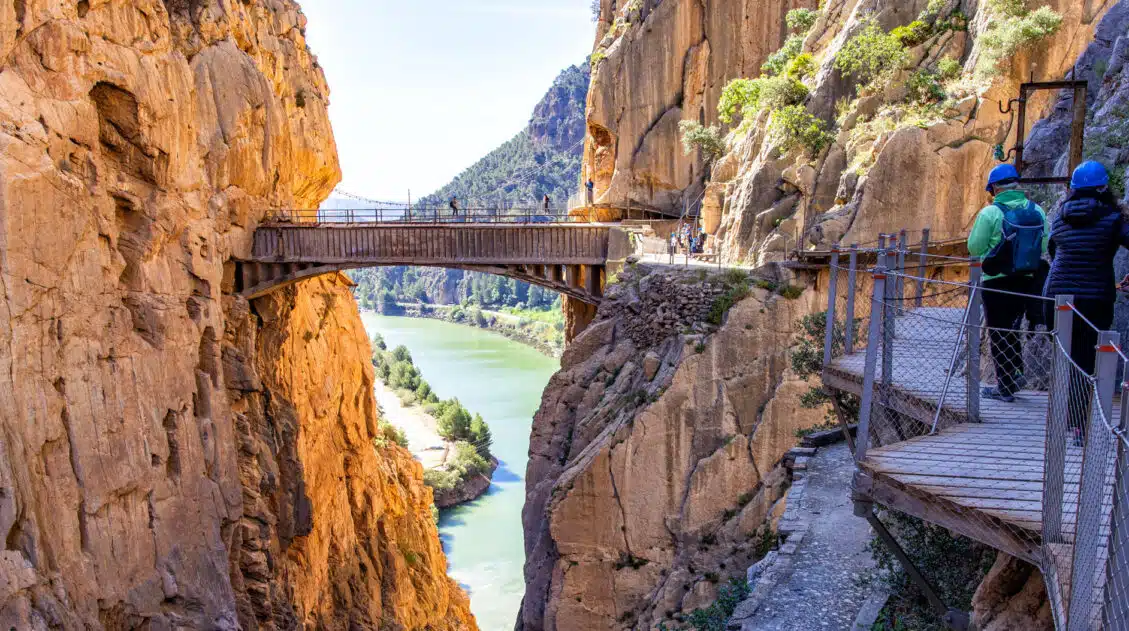
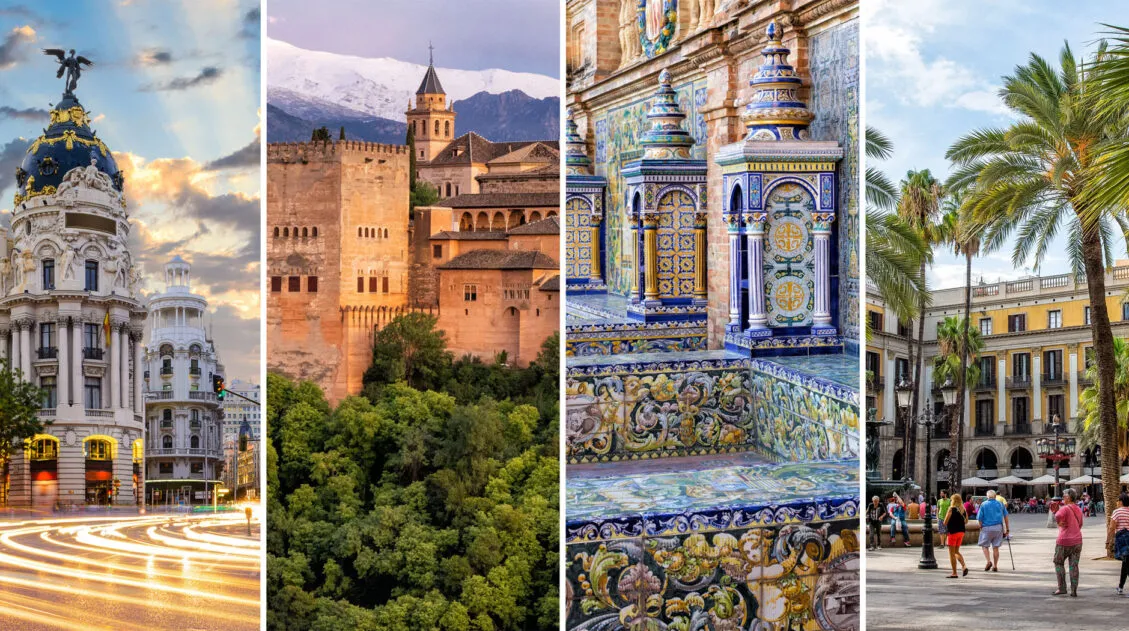
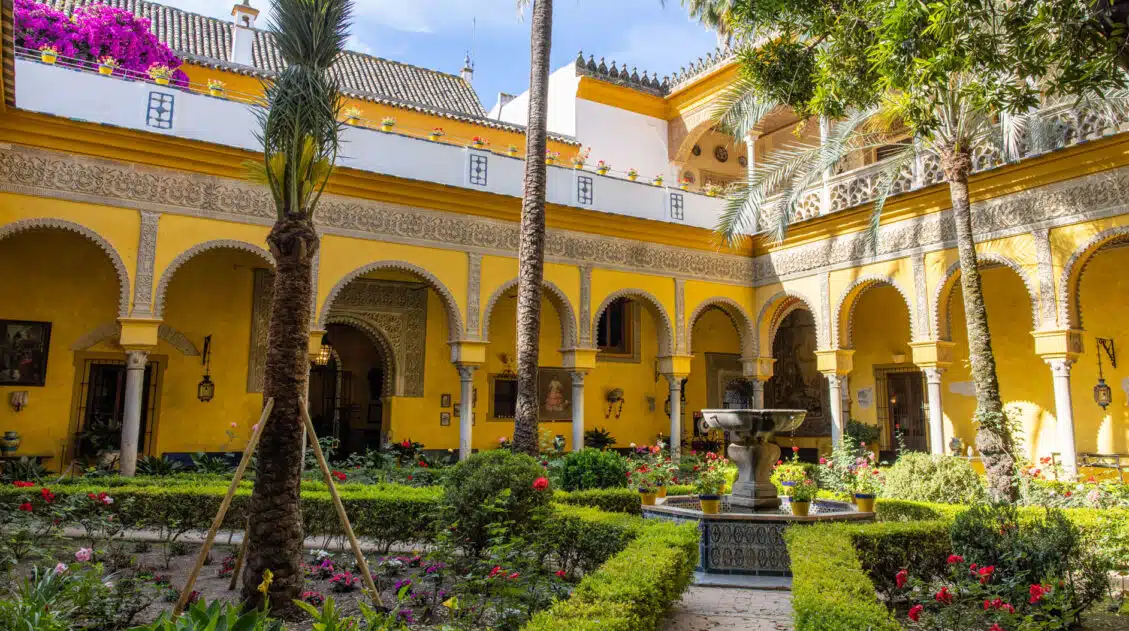
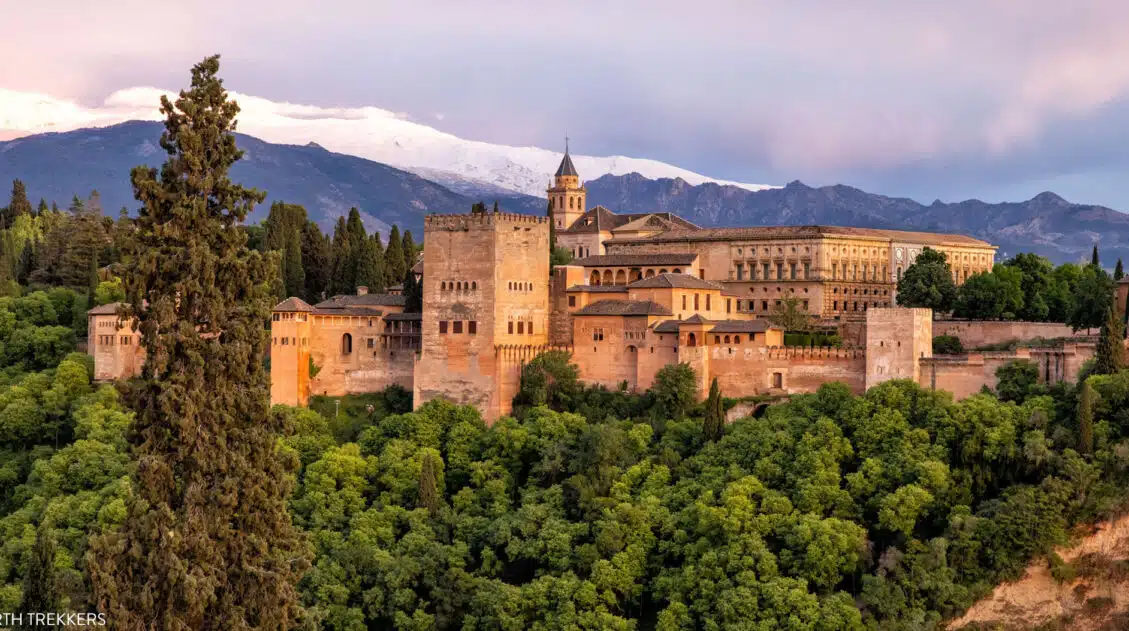
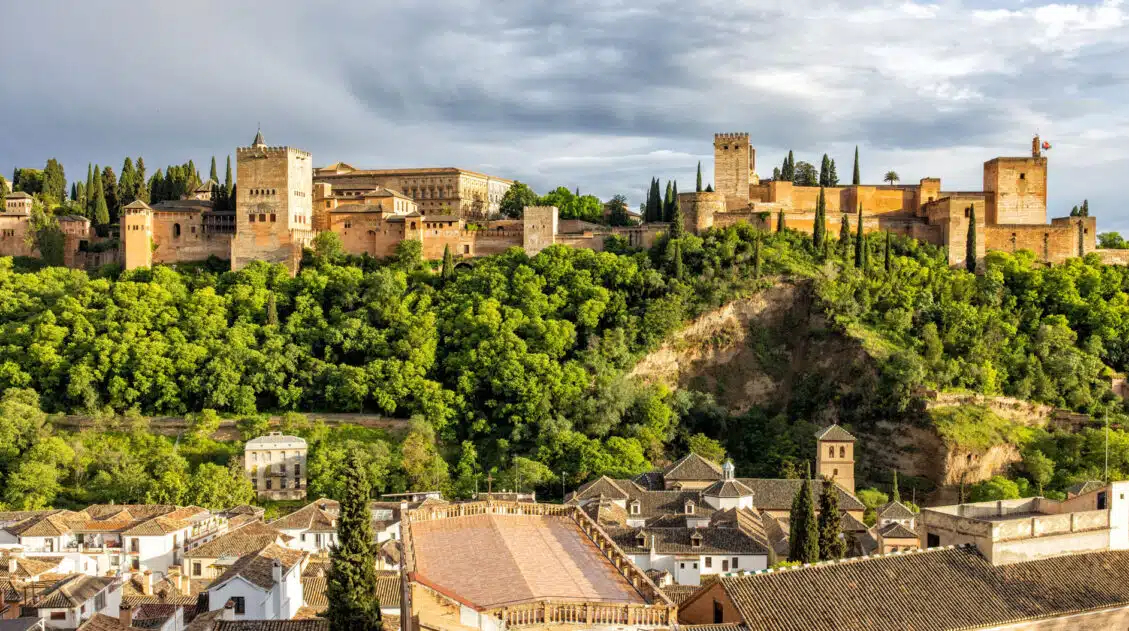
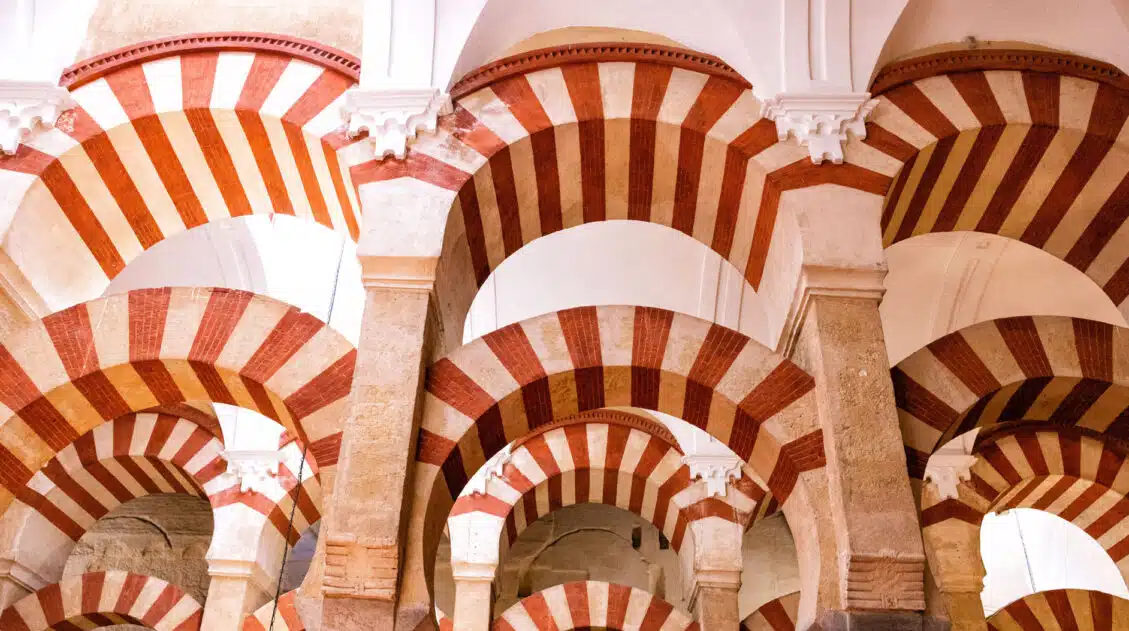
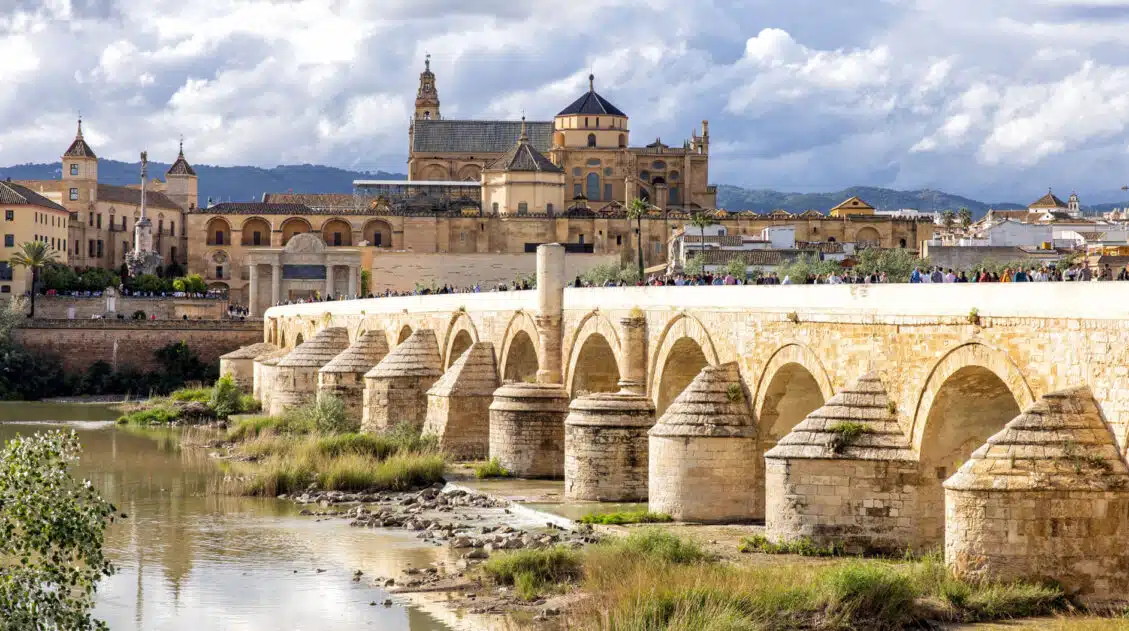
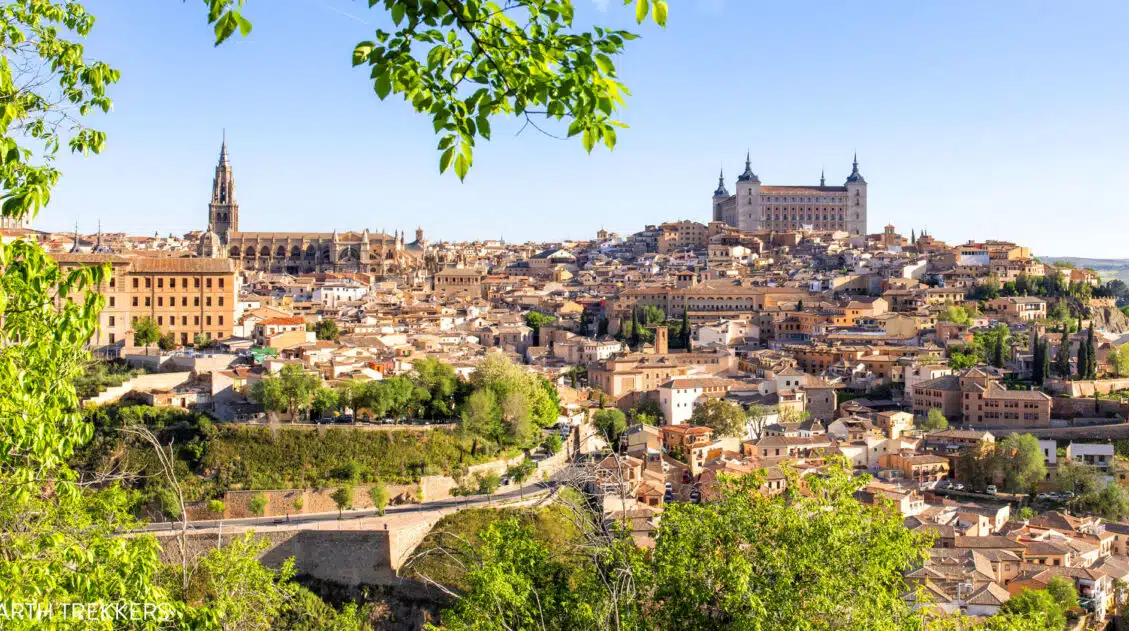
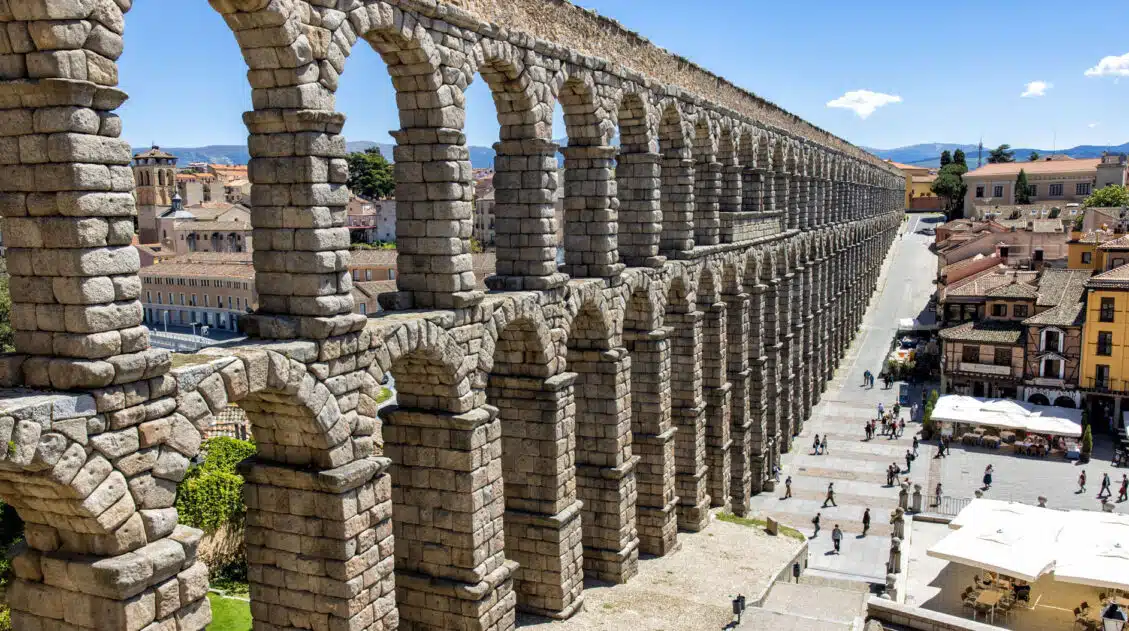

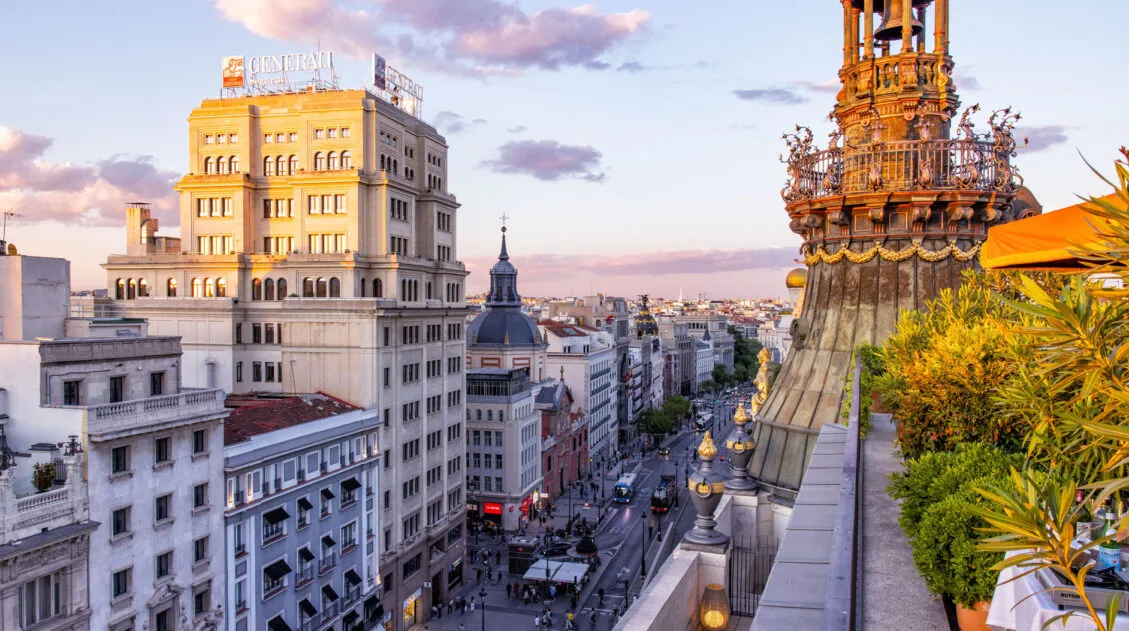
Comments 2